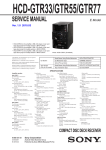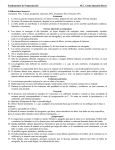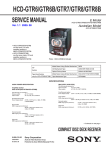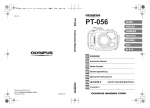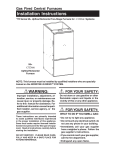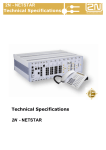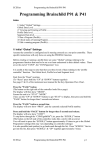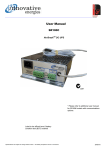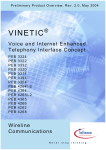Download Packet Telephony Development Kit PSTN Card User`s Guide
Transcript
Freescale Semiconductor User’s Guide PTKITPSTNUG Rev. 1, 9/2005 Packet Telephony Development Kit PSTN Card The public switched telephone network (PSTN) card in the Packet Telephony Development Kit (PDK) connects directly to the PDK baseboard and provides four narrow-band T1/E1 timedivision multiplexing (TDM) ports that interface to the PSTN network. The PSTN subsystem also supports four analog telephony ports for direct interface to standard analog voice terminals. It provides a TDM stream for the DSP array (that is, MSC810xPFC card). Figure 1 shows a snapshot of the PSTN card hardware. © Freescale Semiconductor, Inc., 2005. All rights reserved. CONTENTS 1 2 3 3.1 3.2 3.3 3.4 4 5 6 7 Packet Telephony Development Kit .......................3 Getting Started With the PSTN Card ......................4 PSTN Card Components .........................................4 Time Slot Switch .....................................................5 Digital E1/T1 Interface ...........................................9 PLL Synchronization Module ...............................12 Complex Programmable Logic Device (CLPD) ...14 PSTN Card LEDs and Jumpers .............................16 Power Connector ...................................................17 PSTN Card Interface .............................................17 Default TDM Interface Timing .............................21 CLPD JTAG Power Connector POTS 1 2 3 4 T1/E1 1 2 3 4 Figure 1. PSTN Hardware Overview The PSTN card architecture consists of five main functional blocks, as shown in Figure 2: • Time slot switch. 3.3 V time slot interchange (TSI) digital switch (IDT72V70800). • Digital E1/T1 interface. Quad E1/T1/J1 framer and line interface component for long haul and short haul applications (PEB22554 V1.3). • PLL synchronization module. WAN PLL with single-reference input (IDT82V30001A). • Complex programmable logic device (CPLD). A low power 3.3V 32 macro-cell device (XCR3032XL) used for PLL control, reset, and chip-select management. • Plain Old Telephone Service (POTS). Two dual-channel subscriber line interfaces (PEB3264/-2) for analog telephone access. Packet Telephony Development Kit PSTN Card, Rev. 1 2 Freescale Semiconductor Packet Telephony Development Kit Serial Peripheral Interface (SPI) Analog POTS Lines Analog POTS Reset Time Slot Switch (IDF70800) Microprocessor Bus CPLD ChipSelect Digital E1/T1 Interface T1/E1 Lines Pulse Code Modulation (PCM) Bus PCM System Configuration PLL Synchronization Module IDT-82V3001A Figure 2. PSTN Card Architecture 1 Packet Telephony Development Kit The Packet Telephony Development kit (PDK) is a platform for evaluating and developing voiceover packet applications. The PDK has an MPC8260 host network processor that runs Linus, StarCore™ DSP resource cards that run DSP code, and a Public Switched Telephone Network (PSTN) card with interfaces such as E1/T1 and analog telephone lines (see Figure 3). Telephone Network Managed Packet Network MPC8260 Control Processor Ethernet PSTN StarCore DSP Resource Daughtercard Baseboard Figure 3. Components of the Packet Telephony Development Kit (PTK) The documentation for the kit components is as listed in Table 1. Packet Telephony Development Kit PSTN Card, Rev. 1 Freescale Semiconductor 3 Getting Started With the PSTN Card Table 1. PTK Components and Their Associated Documents Component Document Document ID Baseboard Packet Development Kit Baseboard Hardware User’s Guide PTKITBASEUG MPC8260 Control Processor MPC8260 PowerQUICC II™ Family Reference Manual (Available at the website listed on the back page of this document.) MPC8260UM PSTN Card Packet Development Kit PSTN Card User’s Guide PTKITPSTNUG StarCore DSP Resource Daughtercard • MSC8102 Packet Telephony Farm Card (MSC8102PFC) User’s Guide • MSC8101 Packet Telephony Farm Card (MSC8101PFC) User’s Guide PTKIT8101UG PTKIT8102UG StarCore DSP Resource Reference manuals and other documentation for the MSC81xx products are located at the website listed on the back page of this user’s guide. Software Packet Telephony Development Kit Software User’s Guide CAUTION: 2 PTKITSOFTUG The Packet Telephony Development Kit includes open-construction printed circuit boards that contain static-sensitive components. These boards are subject to damage from electrostatic discharge (ESD). To prevent such damage, you must use static-safe work surfaces and grounding straps, as defined in ANSI/EOS/ESD S6.1 and ANSI/EOS/ESD S4.1. All handling of these boards must be in accordance with ANSI/EAI 625. Getting Started With the PSTN Card This section presents unpacking instructions, hardware preparation, and installation instructions for bringing-up the PSTN card. First, unpack the equipment from the shipping carton. Refer to the packing list and verify that all items are present. Save the packing material for storing and reshipping the equipment. If the shipping carton is damaged upon receipt, request the carrier’s agent to be present during unpacking and inspection of equipment. Most systems have a PSTN card already attached to the baseboard. If you have purchased a PSTN card separately, you must plug it in. The PSTN card cannot operate as a stand-alone unit. The procedure for bringing up the PSTN is as follows: 3 1. Ensure that the PDK baseboard power supply is turned OFF. 2. Ensure that the stands off are connected to the PSTN card. 3. Gently connect the PSTN card PTMC connectors to the PDK baseboard. 4. Twist and tighten the PSTN card stands off to baseboard. 5. Ensure that the PSTN card is properly placed on top of the PDK baseboard. 6. If you plan to use the analog telephones, connect the J17 power connector (see Section 5, Power Connector, on page 17). 7. Turn on the power supply. PSTN Card Components This section discusses the main components of the PSTN card, which are the time slot switch, the digital E1/T1 interface, the PLL synchronization module, and the complex programmable logic device. Packet Telephony Development Kit PSTN Card, Rev. 1 4 Freescale Semiconductor PSTN Card Components 3.1 Time Slot Switch The TSI performs time slot switching to set up and tear down voice connections between communicating entities. IDT-72V70800 is a 4-port switch that is dedicated to switch pulse code modulation (PCM) data between any two ports during call control. It is a non-blocking digital switch that has a capacity of 512 × 512 channels at a serial bit rate of 8.192 Mb/s. Figure 4 shows an overview of the TSI module. Key features of the IDT-72V70800 TSI switch include: • 64-kbit/s PCM channel switching. • Freely programmable streams and time slot control. • Data rate of 8.192 Mb/s equivalents to 128 PCM channels per port. • Transmit to receive channel loop-back for diagnostics. • Microprocessor control mode. • High impedance output control. VCC GND RESET Loopback TX0 RX0 Receive Serial Data Streams RX1 RX2 Output Multiplex Data Memory RX3 Internal Registers Connection Memory TX1 TX2 TX3 Microprocessor Interface Timing Unit CLK FOi Transmit Serial Data Streams FE/ WFPS HCLK AS/ IM DS/ CS R/W/ A[0–7]DTA D[8–15]/ RD ALE WR AD[0–7] Figure 4. TSI Module In the PSTN card, the TSI connects to the codec, Duslic (analog part of the PSTN card), QUADFALC (digital part of the PSTN card), and CPLD. Figure 5 shows an overview of all PSTN modules that connect to the TSI. Table 2 shows how the TSI connects the TDM streams. Table 2. TSI Connections TSI Stream Connects to 0 Baseboard connector 1 E1/T1 PSTN card interface 3 Plain Old Telephone Service (POTS) Analog Telephony PSTN card interface 4 Baseboard connector Packet Telephony Development Kit PSTN Card, Rev. 1 Freescale Semiconductor 5 PSTN Card Components Duslic RJ11 Serial Bus SLIC Infineon Codec PCM2 PCM2 (Infineon) RJ11 PCM3 SLIC Infineon Switch 512 × 512 Duslic RJ11 SLIC Infineon (IDT) Codec (Infineon) RJ11 Microprocessor Bus SLIC Infineon RJ45 T1/E1 RJ45 T1/E1 PCM0 QUADFALC PCM1 PCM0 (Infineon) RJ45 T1/E1 RCLK1 T1/E1 IDT_CSA Microprocessor Bus RJ45 CPLD 8 KHz (Xilinx) WAN PLL 16.384 MHz (IDT) 4.096 MHz Microprocessor Bus 8.192 MHz Figure 5. TSI Connections with Other PSTN Card Modules The TSI is part of the PDK memory map. The MPC8260 device, which resides in the PDK baseboard, can access the TSI via chip select 9. Refer to Table 3 andTable 4 for TSI Base and Option Register settings, as well as UPM programming (MPC8260 memory controller programming to access the TSI). Table 3. TSI Option and Base registers Registers Values BR9 (TSI Base Register) 0xF8010C1 OR9 (TSI Option Register) 0xFFFF8106 Packet Telephony Development Kit PSTN Card, Rev. 1 6 Freescale Semiconductor PSTN Card Components Table 4. Initializing the TSI Operations Instructions Single Read MCMR = 0x10008800 MDR = 0x8FFFF000 MDR = 0x0FFCF380 MDR = 0x0FFCF300 MDR = 0x0FFCF300 MDR = 0x0FFCF300 MDR = 0x0FFCF380 MDR = 0x0FFCF004 MDR = 0x1FFFF001 Single Write MCMR = 0x10008818 MDR = 0x0FF3F300 MDR = 0x0FF0F380 MDR =0x0FF0F300 MDR = 0x0FF0F300 MDR = 0x0FF0F380 MDR = 0x0FF0F004 MDR = 0x0FF0F300 MDR = 0x3FF3F001 Exception MCMR=0x1000883C MDR = 0xFFFFCC05, MDR = 0xFFFFFFFF MDR = 0xFFFFFFFF MDR = 0xFFFFFFFF Run MCMR = 0x00008800 3.1.1 Duslic Module The analog PSTN interface supports four loop start telephone subscriber ports. The Infineon Dual-Channel Subscriber Line Interface Concept (Duslic) PEB-3265 and PEB-4265 devices on the card form the interface between the TDM interface to the TSI and the physical twisted copper pair. There are four RJ-11 physical connectors on the PSTN card, as shown in Figure 6. Packet Telephony Development Kit PSTN Card, Rev. 1 Freescale Semiconductor 7 PSTN Card Components Duslic RJ11 Serial Bus SLIC Infineon Codec (Infineon) RJ11 PCM2 PCM2 PCM3 SLIC Infineon Switch 512 × 512 Duslic RJ11 SLIC Infineon Codec (IDT) (Infineon) RJ11 SLIC Microprocessor Bus Infineon Figure 6. Duslic Connections to other Sub-modules of the PSTN Card The Duslic requires that reset be applied when all the external clocks are stable. The CPLD ensures that the Duslic reset signal is asserted only after the clocks generated by the PLL device are stable, approximately 300 ns or longer after the PLL device undergoes reset. The Duslic performs all the line interface functions generally known in the industry as the BORSCHT functions, as follows: 1. Battery feed [B]. Represents the voltage and current required to power the telephone equipment connected to the line. Battery voltage of –48 to –24 volts is fed directly into the Duslic devices from the PDK power supply 2. Over voltage protection [O]. Protects the PDK from damage to accidental exposure to high voltage, such as those resulting from lightning 3. Ringing [R]. The high voltage low frequency signal activated to ring the telephone equipment. Two programmable ringing modes are supported: balanced ringing where ringing voltage is applied differentially between tip and ring and unbalance ringing in which the ringing voltage is applied singleended to either tip or ring. The ringing voltage of +30 to +60 volts is fed directly into the Duslic devices from the PDK power supply. 4. Signaling or Supervision [S]. Detects ON-hook and OFF-hook states for the telephone equipment connected to the line. ON/OFF hook can be detected while a station is ringing, which is referred to as Ring Trip Detection, or it may can detected while the station is not ringing, which is referred to as Switch Hook Detection. 5. Coding [C]. Converts the analog signals into PCM and vice versa. Two software configurable standard conversion algorithms are supported: A-law and µ-law. The default coding for the PDK is µ-law. The reset value for Duslic is A-law can be programmed to µ-law by changing bit 7 of register BCR3. 6. Hybrid 2-to-4-wire conversions [H]. A special network balancing circuit performs this function to match the line impedance so echo generation can be avoided. Hybrid balancing is a Duslic programmable option. 7. Testing [T]. Allows access to the loop so that regular diagnostic tests can be performed, including: loop resistance measurement, line capacitance, leakage current, ringing voltage, line feed current, and transversal and longitudinal current. Packet Telephony Development Kit PSTN Card, Rev. 1 8 Freescale Semiconductor PSTN Card Components 3.1.2 Duslic Configuration and Operation The Duslic devices are configured directly by the baseboard host processor through the SPI interface. Specific values are written to Duslic registers to configure, for example, a given line into a specific mode of operation. Refer to the Duslic user’s manual for detains on the functions of all registers supported. During normal operation, specific Duslic registers must be read to determine the signaling exchanged between the subscriber telephone set and the PDK. Dynamic conditions that are constantly monitored by the host processor and appropriate action taken include ON-hook/OFF-hook signaling and DTMF signaling. The host processor can also command the Duslic through the SPI interface to generate ringing voltage or tones such as dial tone, busy tone, and reorder or fast busy tone. 3.2 Digital E1/T1 Interface The digital E1/T1 interface supports four E1/T1 ports that can connect to central office (CO) lines such as ISDN PRI or PBX trunks. The Infineon QUADFALC FEB-22554 device forms the interface between the TDM interface to the TSI and the physical twisted copper pair. The QUADFALC recovers the PCM signal on the copper pairs and multiplexes them on the TDM bus to the TSI switch. There are four RJ-45 physical connectors on the PSTN card (see Figure 7). Each of the four digital interfaces of the QUADFALC includes a framer and a Line Interface Unit (LIU), a PLL circuit for clock recovery, an HDLC controller for signaling, and an 8-bit microprocessor interface for configuration. PCM2 PCM2 PCM3 Switch 512 × 512 RJ45 T1/E1 RJ45 T1/E1 Microprocessor Bus (IDT) PCM0 QUADFALC PCM1 PCM0 (Infineon) T1/E1 RJ45 T1/E1 RCLK1 RJ45 IDT_CSA Microprocessor Bus 8 KHz CPLD (Xilinx) WAN PLL 16.384 MHz (IDT) 4.096 MHz Microprocessor Bus 8.192 MHz Figure 7. QUADFALC Connecting to Other Sub-modules of the PSTN Card Packet Telephony Development Kit PSTN Card, Rev. 1 Freescale Semiconductor 9 PSTN Card Components 3.2.1 QUADFALC Clocking Options The QUADFALC clocking configuration and the WAN-PLL device-clocking configuration jointly determine the timing mode. Two timing modes are supported: master and slave clocking. The combination of master or slave options provides maximum flexibility for telecommunications equipment developers using the PSTN card. In master clocking mode, the QUADFALC derives its timing from its local free running 16.384 MHz free running clock, as shown in Figure 8. The derived clock is either 1.544 MHz for T1 operation in North America or 2.048 MHz for E1 operation in Europe. This derived clock becomes the timing reference for the WAN-PLL device, which generates all the system clocks, including the PCM clocks for the PDK. T1/E1 T1/E1 PEB-22554 QUADFALC T1/E1 F-ref (To WAN-PLL Device) RCLK1 T1/E1 1.544/2.048 MHz MCLK 16.384 MHz XTAL Osc 20 ppm (Sync Source) Figure 8. QUADFALC Master Clocking Mode Configuration In slave clocking mode, the QUADFALC derives its timing reference from one of the four T1/E1 line terminated directly on the QUADFALC device as illustrated inFigure 9. The 1.544 MHz or 2.048 MHz derived clock is fed into the WAN-PLL device, which generates the system PCM clocks. Clocking for the QUADFALC is supplied through the MCLK pin; for the PDK this clock has a frequency of 16.384 MHz. Packet Telephony Development Kit PSTN Card, Rev. 1 10 Freescale Semiconductor PSTN Card Components T1/E1 PEB-22554 QUADFALC T1/E1 T1/E1 F-ref (To WAN-PLL Device) RCLK1 T1/E1 1.544/2.048 MHz MCLK 16.384 MHz XTAL Osc (20 ppm) Figure 9. QUADFALC Slave Clocking Mode Configuration 3.2.2 QUADFALC Default Operating Mode The QUADFALC is part of the PDK memory map, and the MPC8260 device, which resides in the PDK baseboard, can access the QUADFALC via chip select 8. Refer to Table 5 and Table 6 for QUADFALC Base and Option Register values, as well as UPM programming Table 5. QUADFALC Option and Base Registers Registers Values BR8 (QUADFALC Base Register) 0xF70008A1 OR8 (QUADFALC Option Register) 0xFFFF8106 Table 6. QUADFALC UPM Programming Operations Instructions Single Read MBMR = 0x10015400 MDR = 0x8FFFF000 MDR = 0x0FFCF300 MDR = 0x0FFCF300 MDR = 0x0FFCF004 MDR = 0x0FFFF300 MDR = 0x0FFFF300 MDR = 0x3FFFF001 Packet Telephony Development Kit PSTN Card, Rev. 1 Freescale Semiconductor 11 PSTN Card Components Table 6. QUADFALC UPM Programming (Continued) Operations Instructions Single Write MBMR = 0x10015418 MDR = 0x0FF3F000 MDR = 0x0FF0F300 MDR = 0x0FF0F300 MDR = 0x0FF0F004 MDR = 0x0FF3F300 MDR = 0x0FF3F300 MDR = 0x3FF3F001 Exception MBMR=0x1001543C MDR= 0xFFFFCC05, Run MBMR=0x00015400 3.3 PLL Synchronization Module The IDT-82V3001 PLL device generates timing (clock) and synchronization (framing) signals for the PCM bus. The IDT82V3001A is a WAN PLL with single reference input. It contains a Digital Phase-Lock Loop (DPLL), which generates clock and framing signals that are phase locked to a 2.048 MHz, 1.544 MHz, or 8 kHz input reference. The PLL circuitry generates all TDM synchronization clocks used in the PDK, including the PCM interface clocks. These clocks can either be generated locally (via the QUADFALC device) if the PDK is operating in Master mode or be derived from any one of the T1/E1 lines by the QUADFALC if the PDK is operating in Slave mode. The two relevant modes of operation for the IDT82V3001 are Free Run mode and Normal mode. 3.3.1 Free Run Mode In Free Run mode, the PLL device uses its local clock (as opposed to the reference frequency) to synthesize the system clock. The Free Run clocking mode for IDT-82V3001 is not used; only the Normal clocking mode is used, as described in the following section. 3.3.2 Normal Mode When the PLL device is configured in Normal mode, the frequency reference is received from the QUADFALC, as illustrated in Figure 10. The timing reference fed into the PLL device is derived from one of the T1/E1 lines. In this case, the second line is used as the timing reference source. However, any of the four digital lines terminated on the PSTN card can be used as the timing reference source. This is a QUADFALC software configuration feature. Packet Telephony Development Kit PSTN Card, Rev. 1 12 Freescale Semiconductor PSTN Card Components SCLKR1 T1/E1 SCLKX XPA1 T1/E1 PEB-22554 QUADFALC T1/E1 RCLK1 T1/E1 F-ref 1.544/2.048 MHz C8 8.192M F8 8K PCM System Bus MCLK IDT82V3001 Sync 16.384 MHz XTAL Osc (20 ppm) C4 4.096M C16 16.384M IDT TSI Switch Figure 10. WAN-PLL Device in Support of Slave Clocking Mode To operate the PLL device in Normal mode, the Mode_sel_0 signal must be set to 0, and the Mode_sel_1 signal must be set to 0 through the CPLD, as shown in Table 7. To complete the PLL configuration, the input reference frequency into the PLL must also be selected. In this case, the PRI frequency is 1.544 MHz in North America or 2.048 MHz in Europe. Frequency selection of 1.544 MHz (North America) is achieved by setting Freq_sel_0 = 0 and Freq_sel_1 = 1 via the CPLD. For Europe, the values are Freq_sel_0 = 1 and Freq_sel_1 = 1 via the CPLD. Table 7. ID72V3001 Normal Mode Configuration Mode Select Frequency Select Comment mode_sel_1 mode_sel_0 Freq_sel_1 Freq_sel_0 0 0 1 0 North America 0 0 1 1 Europe If the PDK is operating in Master clocking mode, the frequency reference is generated locally by the QUADFALC and fed directly into the PLL device. Software can configure the QUADFALC to source a free running clock from it local 16.384 MHz oscillator fed through the MCLK pin. This clock has a stability of 20 ppm, as illustrated in Figure 11. Packet Telephony Development Kit PSTN Card, Rev. 1 Freescale Semiconductor 13 PSTN Card Components SCLKR1 T1/E1 SCLKX XPA1 T1/E1 PEB-22554 QUADFALC T1/E1 RCLK1 T1/E1 F-ref C8 1.544/2.048 MHz 8.192 MHz PCM 8 KHz F8 System Bus MCLK IDT82V3001 Sync 16.384 MHz C4 XTAL Osc (20 ppm) C16 4.096 MHz IDT 16.384 MHz TSI Switch Figure 11. WAN-PLL in support of Master Clocking Mode The default clocking option for the PDK is Master synchronization as illustrated in Figure 11. The default reference clock fed into the PLL device from the QUADFALC is 1.544 MHz, representing the North American digital transmission line standard. 3.4 Complex Programmable Logic Device (CLPD) The glue logic to help control access and configuration of all devices on the PSTN card is implemented on a CPLD. The CPLD decodes the addresses to generate the chip select for the TSI device and the control signals for the PLL device. The CPLD also monitors the PLL device and generates the Loss of Synchronization signal for the operation status indicator or LED. 3.4.1 Chip-Select Logic The CPLD uses address line 22 to select between assertion of the IDT time-slot switch and accesses to its own internal registers, as shown in Table 8. Table 8. Chip-Select Truth Table PQ2_CS_TDM2 Chip Select Input From the Baseboard CONN_AD22 Address Line Input From the Baseboard IDT Time Slot Switch Chip Select Internal CPLD Chip Select 1 X 1 1 0 0 0 1 0 1 1 0 Packet Telephony Development Kit PSTN Card, Rev. 1 14 Freescale Semiconductor PSTN Card Components 3.4.2 Output Signals Writes to the memory-mapped registers control the output signals on the CPLD. Table 9 lists and describes the registers. The address column refers to the address from which to write over the bus A[22–31]. The physical address pins to the CPLD are only A[22–30]. The data bus bit is latched on to the output signal. Thus, to turn off the LED, for example, one would write a value of 0x01 to address 0x20E. The physical address lines CONN_AD[22–30] would be 100000111 and the 1 from D[15] would be latched causing the PLD_LOS_FALC signal to go high. Table 9. CPLD Memory Map Data Bus Bit Read/ Write Default Value PLD_MODE_SEL0 D[14] R/W 0 PLD_MODE_SEL1 D[15] R/W 0 PLD_F_SEL0 D[14] R/W 1 PLD_F_SEL1 D[15] R/W 1 0x204 NORMAL_PLD D[15] R — Goes high when the WAN PLL goes into Normal mode. 0x206 LOCK_PLD D[15] R — Goes high when the WAN PLL is locked to the input reference frequency. 0x208 PLD_TCLRn D[15] R/W 1 Logic low at this signal resets the TIE control block of the WAN PLL, resulting in a realignment of the output phase with the input phase. 0x20A PLD_TIE_en D[15] R/W 1 Logic high at this signal enables the TIE block of the WAN PLL. 0x20C PLD_DUSLIC_TSI_RST n D[15] R/W 1 Logic low at this signal resets the DuSLIC (U1 & U2) and TSI switch. 0x20E PLD_LOS_FALC D[15] R/W 1 Logic low at this signal lights an LED. 0x210 HOLDOVER_PLD D[15] R — Goes to a logic high when the WAN PLL goes to Holdover mode. 0x212 PLD_WAN_PLL_RSTn D[15] R/W 1 Logic low at this signal resets the WAN PLL. Address 0x200 0x202 Output Signal Name Description Determine the state (Normal, Holdover, or Free Run) of the WAN PLL. Determine the input reference frequency of the WAN PLL. 3.4.3 JTAG The J16 header is used for programming the CPLD. The PSTN card comes programmed and use of this header should not be needed. 1RWH 'RQRWUHFRQILJXUHWKH;LOLQ[FKLSLQWKH3671FDUG$WWHPSWVWRGRVRPD\OHDGWRLQVWDELOLW\LQ WKHV\VWHP Table 10. Xilinx JTAG Signals Pin JTAG Signal 1 +5V 2 GND 3 NC 4 TCK Packet Telephony Development Kit PSTN Card, Rev. 1 Freescale Semiconductor 15 PSTN Card LEDs and Jumpers Table 10. Xilinx JTAG Signals (Continued) Pin JTAG Signal 5 NC 6 TDO 7 TDI 8 NC 9 TMS The only module that connects to the baseboard JTAG chain is the QUADFALC. PTMC connector J15 enables the JTAG chain between the baseboard and the PSTN card. 1RWH 7KHEDVHERDUG-7$*FKDLQPXVWEHFRQILJXUHGWRDGGWKH3671-7$*ZLWKWKHEDVHERDUG-7$* FKDLQ5HIHUWRWKHEDVHERDUGXVHU¶VPDQXDOIRUGHWDLOVRQ-7$*FKDLQFRQILJXUDWLRQ 4 PSTN Card LEDs and Jumpers This section describes the LEDs and jumpers of the PSTN card. Table 11. PSTN Card LEDs LED Description 1 Indicates the Hook Status of the analog subscriber line 1 (P1.B1). LED1 is controlled by the port IO1B of the PEB3265 It can be programmed to show the ON/OFF hook status for the corresponding subscriber line. 2 Indicates the Hook Status of the analog subscriber line 2 (P1.B1). LED2 is controlled by the port IO1A of the PEB3265 It can be programmed to show the ON/OFF hook status for the corresponding subscriber line. 3 Indicates the Hook Status of the analog subscriber line 3 (P1.D1). LED3 is controlled by the port IO1B of the PEB3265 It can be programmed to show the ON/OFF hook status for the corresponding subscriber line. 4 Indicates the Hook Status of the analog subscriber line 4 (P1.C1). LED4 is controlled by the port IO1A of the PEB3265 It can be programmed to show the ON/OFF hook status for the corresponding subscriber line. 5 Shows the Loss Of Signal/Synchronization status of the QUADFALC device. It connects to a GPIO (pin no. 23) of the CPLD. It is illuminated when the processor determines the Loss of Signal status after reading the Frame Receive Status Register 0 (FRS0) of the QUADFALC. 6 3.3V power indication on PSTN. It is illuminated when 3.3V power rail is active. 7 5V power indication on PSTN card. It is illuminated to indicate that the 3.3V voltage is available on the board. 8 VHR (Ringing Voltage) power indication on PSTN card. It is illuminated to indicate ringing voltage is available. 9 VBATHX (Battery Voltage) power indication on PSTN. It is illuminated to indicate that the battery or line voltage is available on the board. 1RWH )RUWKHMXPSHUVHWWLQJV21PHDQVSODFHMXPSHUDQG2))PHDQVQRMXPSHU Packet Telephony Development Kit PSTN Card, Rev. 1 16 Freescale Semiconductor Power Connector Table 12 summarizes all jumper settings in the PSTN card. Jumper settings are verified before they are shipped to customers. Table 12. Jumper Settings Jumper Default Setting Switches between T1 and E1 termination. Shunt pins 1–2: E1. Shunt pins 2–3: T1. T1 (Pins 2–3 connected) Selects source of +3.3V power supply. Shunt pins 1–2: Power comes from power connector J17. Shunt pins 2–3: Power comes from the baseboard Baseboard power (Pins 2–3 connected) J18 Selects source of +5V power supply. Shunt pins 1–2: Power comes from power connector J17. Shunt pins 2–3: Power comes from the baseboard. Baseboard power (Pins 2–3 connected) J19 Selects source of VHR (Ringing) power supply. Shunt pins 1-2: Power comes from power connector J17. Shunt pins 2-3: Power comes from the baseboard. Baseboard power (Pins 2–3 connected) J20 J1–J11 5 Meaning Power Connector Table 13 lists all power supplies used in the PSTN card from J17. The 48 V battery supply must be sourced through this connector. All other supplies can come either from the baseboard or through J17 by using jumpers J18–J20. Table 13. PSTN Card Power Supply Distribution Pin Description 3.3 V I/O power. By default, the 3.3 V power comes from the baseboard. See Table 12. +5 V 5 V power. By default, the 5 V power comes from the baseboard. See Table 12. 3 +48 V Ringing voltage for telephones. 4 –48 V Battery supply for telephones. 5 GND 6 GND 1 2 6 Value PSTN Card Interface The baseboard and the PSTN card share common signals, such as address, data, and control lines. The signals travel through PTMC connectors that connect the PDK baseboard to the PSTN card, as shown in Figure 12. Packet Telephony Development Kit PSTN Card, Rev. 1 Freescale Semiconductor 17 PSTN Card Interface P13 P15 P14 Figure 12. Baseboard PTMC Connected Table 14. PTMC 15 Header Pin Signal Pin Signal 1 TDM_SPI_CS1 2 JTAG_TRST 3 JTAG_TMS 4 TDM_TDO 5 TDM_TDI 6 GND 7 GND 8 JTAG_TCK 9 CONN_D0 10 CONN_AD23 11 CONN_D1 12 Vcc (5.0 v) 13 TDM_RESET 14 CONN_AD24 15 Vcc (5.0 v) 16 CONN_AD25 17 CONN_D2 18 GND 19 CONN_D3 20 CONN_AD26 21 GND 22 CONN_AD27 23 CONN_D4 24 Vcc (3.3 v) 25 CONN_D5 26 CONN_AD28 27 Vcc (3.3 v) 28 CONN_AD29 29 CONN_D6 30 GND 31 CONN_D7 32 CONN_AD30 33 GND 34 CONN_AD31 35 CONN_D8 36 Vcc (3.3 v) 37 GND 38 TDM_TO_PQ2_INT1 39 CONN_D9 40 GND 41 Vcc (3.3 v) 42 PQ2_CS_TDM1 43 CONN_D10 44 GND 45 CONN_D11 46 TDM_GPL2 Packet Telephony Development Kit PSTN Card, Rev. 1 18 Freescale Semiconductor PSTN Card Interface Table 14. PTMC 15 Header (Continued) Pin Signal Pin Signal 47 GND 48 TDM_GPL1 49 CONN_D12 50 Vcc (3.3 v) 51 CONN_D13 52 PQ2_CS_TDM2 53 Vcc (3.3 v) 54 TDM_SPI_CS0 55 CONN_D14 56 GND 57 CONN_D15 58 TDM_SPIMOSO 59 GND 60 TDM_SPIMOSI 61 CONN_AD22 62 Vcc (3.3 v) 63 GND 64 TDM_SPICLK Table 15. PTMC 14 Header Pin Signal Pin Signal 1 NC 2 GND 3 GND 4 VCC (5.0 V) 5 NC 6 NC 7 VCC (5.0 V) 8 GND 9 NC 10 VCC (5.0 V) 11 VCC (5.0 V) 12 NC 13 NC 14 GND 15 GND 16 NC 17 CT_FRAME_A 18 VCC (5.0 V) 19 NC 20 GND 21 NC 22 NC 23 NC 24 VCC (5.0 V) 25 CT_C8_A 26 GND 27 GND 28 NC 29 NC 30 NC 31 NC 32 GND 33 GND 34 NC 35 NC 36 VCC (5.0 V) 37 NC 38 GND 39 NC 40 NC 41 NC 42 VCC (5.0 V) Packet Telephony Development Kit PSTN Card, Rev. 1 Freescale Semiconductor 19 PSTN Card Interface Table 15. PTMC 14 Header (Continued) Pin Signal Pin Signal 43 NC 44 GND 45 GND 46 NC 47 NC 48 NC 49 NC 50 NC 51 GND 52 NC 53 NC 54 NC 55 CT_D4 56 GND 57 VCC (5.0 V) 58 CT_D5 59 NC 60 NC 61 CT_D0 62 GND 63 GND 64 CT_D1 Table 16. PTMC 13 Header Pin Signal Pin Signal 1 NC 2 NC 3 GND 4 NC 5 NC 6 NC 7 NC 8 VCC (5.0 V) 9 NC 10 NC 11 GND 12 NC 13 NC 14 GND 15 GND 16 NC 17 NC 18 VCC (5.0 V) 19 VCC (3.3 V) 20 NC 21 NC 22 NC 23 NC 24 GND 25 GND 26 NC 27 NC 28 NC 29 NC 30 VCC (5.0 V) 31 NC 32 NC 33 NC 34 GND 35 GND 36 NC 37 NC 38 VCC (5.0 V) Packet Telephony Development Kit PSTN Card, Rev. 1 20 Freescale Semiconductor Default TDM Interface Timing Table 16. PTMC 13 Header (Continued) 7 Pin Signal Pin Signal 39 GND 40 NC 41 NC 42 NC 43 NC 44 GND 45 VCC (3.3 V) 46 NC 47 NC 48 NC 49 NC 50 VCC (5.0 V) 51 GND 52 NC 53 NC 54 NC 55 TDM_GPIO2 56 GND 57 VCC (3.3 V) 58 TDM_TO_PQ2_INT2 59 TDM_GPIO1 60 TDM_TO_PQ2_INT3 61 TDM_GPIO0 62 VCC (5.0 V) 63 GND 64 NC Default TDM Interface Timing Figure 13 diagrams the PSTN default TDM interface to the DSP daughter card. The default is 128 channels per frame, 8 bits per channel. This yields 8.192 Mbps with an 8 K Hz frame synchronization signal. 122.0 ns (8.192 MHz) CT_C8_A (Clock) FRAME_A (Frame) 125 µ s (8 KHz) 122 ns 10.8 ns CT_D0 (Rx Data) Bit 1 Bit 2 Bit 3 Bit 4 22.8 ns CT_D1 (Tx Data) Bit 1 Bit 2 Bit 3 Bit 4 Figure 13. PSTN Card Default TDM Interface Packet Telephony Development Kit PSTN Card, Rev. 1 Freescale Semiconductor 21 Default TDM Interface Timing Appendix A CPLD Source library IEEE; use IEEE.STD_LOGIC_1164.ALL; use IEEE.STD_LOGIC_ARITH.ALL; use IEEE.STD_LOGIC_UNSIGNED.ALL; --declaration of INPUT and OUTPUT ports entity pdk_cpld is Port ( PQ2_CS_TDM2 CONN_AD22 CONN_AD : in std_logic; : in std_logic; : in std_logic_vector(27 to 30); CONN_D13 : out std_logic; CONN_D14 : in std_logic; CONN_D15 : in std_logic; TDM_GPL1 : in std_logic; TDM_GPL2 : in std_logic; HOLDOVER_PLD : in std_logic; LOCK_PLD : in std_logic; NORMAL_PLD : in std_logic; CT_C8_A : in std_logic; TDM_RESET : in std_logic; CT_FRAME : in std_logic; CT_STFRAMEn : in std_logic; CT_WFRAMEn : in std_logic; PLD_MODE_SEL0 : out std_logic; PLD_MODE_SEL1 : out std_logic; PLD_F_SEL0 : out std_logic; PLD_F_SEL1 : out std_logic; PLD_TCLRn : out std_logic; PLD_TIE_en : out std_logic; PLD_DuSLIC_TSI_RSTn : out std_logic; PLD_WAN_PLL_RSTn : out std_logic; PLD_LOS_FALC : out std_logic; PLD_IDT_CSn : out std_logic; CT_FRAME_A : out std_logic; PLD_QFALC_FRAME : out std_logic); end pdk_cpld; architecture pdk_cpld of pdk_cpld is signal signal_main_dec: std_logic;-- internal signal whic enables address decoder signal signal_cpld_dec: std_logic_vector( 11 downto 0 ); -- internal signals which are out from address decoder signal signal_r_w_bar : std_logic; signal signal_w_bar :std_logic; signal signal_r :std_logic; signal sel_mux1: std_logic_vector(1 downto 0); -- select signals to select frame sync for Base card connectors signal sel_mux2: std_logic_vector(1 downto 0); -- select signals to select frame sync for QuadFALC (optional) begin -- two bit decoder which selects IDT switch or address decoder of CPLD. process(PQ2_CS_TDM2,CONN_AD22) begin -- the selection between IDT switch and cpld address decoder is done depending -- upon status of PQ2_CS_TDM2 and CONN_AD22 .If PQ2_CS_TDM2 is 0 the selection -- between IDT switch and CPLD address decoder is done based on CONN_AD22, -- if CONN_AD22 is 0 then IDT switch is selected or if CONN_AD22 is 1 then -- CPLD address decoder is selected, else if PQ2_CS_TDM2 = 1 then both -- IDT switch and CPLD address decoder will be disabled. if ( PQ2_CS_TDM2 = ’0’ and CONN_AD22 =’0’)then PLD_IDT_CSn <= ’0’; signal_main_dec <= ’1’; elsif ( PQ2_CS_TDM2 = ’0’ and CONN_AD22 = ’1’)then PLD_IDT_CSn <= ’1’; signal_main_dec <= ’0’; else Packet Telephony Development Kit PSTN Card, Rev. 1 22 Freescale Semiconductor Default TDM Interface Timing PLD_IDT_CSn <= ’1’; signal_main_dec <= ’1’; end if; end process; --end of two bit decoder --Following process is to implement the CPLD address decoder,which will be --enabled by output signal "signal_main_dec" of two bit decoder. --Inputs for this decoder are AD[27:30] ,out put will be nine enable signals --for internal latchs. process(signal_main_dec,CONN_AD) begin if ( signal_main_dec = ’0’) then case CONN_AD is when "0000" => signal_cpld_dec <= "111111111110"; when "0001" => signal_cpld_dec <= "111111111101"; when "0010" => signal_cpld_dec <= "111111111011"; when "0011" => signal_cpld_dec <= "111111110111"; when "0100" => signal_cpld_dec <= "111111101111"; when "0101" => signal_cpld_dec <= "111111011111"; when "0110" => signal_cpld_dec <= "111110111111"; when "0111" => signal_cpld_dec <= "111101111111"; when "1000" => signal_cpld_dec <= "111011111111"; when "1001" => signal_cpld_dec <= "110111111111"; when "1010" => signal_cpld_dec <= "101111111111"; when "1011" => signal_cpld_dec <= "011111111111"; when others => signal_cpld_dec <= "111111111111"; end case; else signal_cpld_dec <= "111111111111"; end if; end process; --end of CPLD address decoder ------ Following process is to implement the two bit latch for mode select signals for WAN PLL. Default mode is NORMAL MODE i.e both signals are 0. WAN PLL mode can be changed by writing into latch at address CONN_AD[22:30] = 1XXXX0000 using CONN_D[14:15] process (signal_cpld_dec(0),TDM_RESET,CONN_D15,CONN_D14,signal_w_bar) begin if TDM_RESET =’0’ then PLD_MODE_SEL0 <= ’0’; PLD_MODE_SEL1 <= ’0’; elsif signal_cpld_dec(0) = ’0’ and signal_w_bar = ’0’ then PLD_MODE_SEL0 <= CONN_D15; PLD_MODE_SEL1 <= CONN_D14; end if ; end process; ------ implementation of two bit latch for Input reference frequency select signals for WAN PLL. Default Input reference frequency is 1.544 MHz(T1 mode). WAN PLL Input reference frequency can be changed by writing into latch at address CONN_AD[22:30] = 1XXXX0001 using CONN_D[14:15] process (signal_cpld_dec(1),CONN_D15,CONN_D14,signal_w_bar,TDM_RESET) begin if TDM_RESET =’0’ then PLD_F_SEL0 <= ’0’; PLD_F_SEL1 <= ’1’; elsif signal_cpld_dec(1) = ’0’and signal_w_bar = ’0’ then PLD_F_SEL0 <= CONN_D15; Packet Telephony Development Kit PSTN Card, Rev. 1 Freescale Semiconductor 23 Default TDM Interface Timing PLD_F_SEL1 <= CONN_D14; end if ; end process; -- implementation of status read signal (NORMAL_PLD) of WAN PLL at ADDRESS -- CONN_AD[22:30] = 1XXXX0010 using CONN_D[15] process ( signal_r,NORMAL_PLD,HOLDOVER_PLD,LOCK_PLD,signal_cpld_dec(2),signal_cpld_dec(8),signal_cpld_dec(3)) begin if signal_cpld_dec(2) = ’0’ and signal_r = ’1’ then CONN_D13 <= NORMAL_PLD; -- implementation of status read signal(HOLDOVER_PLD) of WAN PLL at ADDRESS -- CONN_AD[22:30] = 1XXXX1000 using CONN_D[15] elsif signal_cpld_dec(8) = ’0’ and signal_r = ’1’ then CONN_D13 <= HOLDOVER_PLD; -- implementation of status read signal(LOCK_PLD) of WAN PLL at ADDRESS --CONN_AD[22:30] = 1XXXX0011 using CONN_D[15] elsif signal_cpld_dec(3) = ’0’ and CONN_D13 <= LOCK_PLD; else CONN_D13 <= ’Z’; end if; signal_r = ’1’ then end process; -- implementation of one bit latch for signal(PLD_TCLRn)of WAN PLL at ADDRESS -- CONN_AD[22:30] = 1XXXX0100 using CONN_D[15] -- default PLD_TCLRn <= 1 process (signal_cpld_dec(4),TDM_RESET,CONN_D15,signal_w_bar) begin if TDM_RESET =’0’ then PLD_TCLRn <= ’1’; elsif signal_cpld_dec(4) = ’0’ and signal_w_bar = ’0’ then PLD_TCLRn <= CONN_D15 ; end if ; end process; -- implementation of one bit latch for signal(PLD_TIE_en)of WAN PLL at ADDRESS -- CONN_AD[22:30] = 1XXXX0101 using CONN_D[15] -- default PLD_TIE_en <= 1 process (signal_cpld_dec(5),TDM_RESET,CONN_D15,signal_w_bar) begin if TDM_RESET =’0’ then PLD_TIE_en <= ’1’; elsif signal_cpld_dec(5) = ’0’and signal_w_bar = ’0’ then PLD_TIE_en <= CONN_D15; end if ; end process; -- implementation of one bit latch for signal(PLD_DuSLIC_TSI_RSTn) for DuSLIC and TSI reset -- ADDRESS CONN_AD[22:30] = 1XXXX0110 using CONN_D[15] -- default PLD_DuSLIC_TSI_RSTn <= 1 at process (signal_cpld_dec(6),TDM_RESET, CONN_D15,signal_w_bar) begin if TDM_RESET =’0’ then PLD_DuSLIC_TSI_RSTn <= ’1’; Packet Telephony Development Kit PSTN Card, Rev. 1 24 Freescale Semiconductor Default TDM Interface Timing elsif signal_cpld_dec(6) = ’0’ and signal_w_bar = ’0’then PLD_DuSLIC_TSI_RSTn <= CONN_D15; end if ; end process; -- implementation of one bit latch for signal(PLD_LOS_FALC) for FALC at -- ADDRESS CONN_AD[22:30] = 1XXXX0111 using CONN_D[15] -- default PLD_LOS_FALC <= 1 process (signal_cpld_dec(7),TDM_RESET,CONN_D15,signal_w_bar) begin if TDM_RESET =’0’ then PLD_LOS_FALC <= ’1’; elsif signal_cpld_dec(7) = ’0’and signal_w_bar = ’0’ then PLD_LOS_FALC <= CONN_D15; end if ; end process; -- implementation of one bit latch for signal(PLD_WAN_PLL_RSTn) for WAN PLL reset -- ADDRESS CONN_AD[22:30] = 1XXXX1001 using CONN_D[15] -- default PLD_WAN_PLL_RSTn <= 1 at process (signal_cpld_dec(9),TDM_RESET, CONN_D15,signal_w_bar) begin if TDM_RESET =’0’ then PLD_WAN_PLL_RSTn <= ’1’; elsif signal_cpld_dec(9) = ’0’ and signal_w_bar = ’0’then PLD_WAN_PLL_RSTn <= CONN_D15; end if ; end process; -- Following process is to implement the two bit internal latch for select signals -- of MUX1 used to to select frame sync for base card connectors. -- Default mode is sel_mux1(0) <= ’0’; and sel_mux1(1) <= ’1’; i.e -- CT_FRAME = CT_FRAME_A (F8o from WAN PLL) -- MUX1 enable signals can be changed by writing into latch at address -- CONN_AD[22:30] = 1XXXX1010 using CONN_D[14:15] process (signal_cpld_dec(10),CONN_D15,CONN_D14,signal_w_bar,TDM_RESET) begin if TDM_RESET =’0’ then sel_mux1(0) <= ’0’; sel_mux1(1) <= ’1’; elsif signal_cpld_dec(10) = ’0’and signal_w_bar = ’0’ then sel_mux1(0) <= CONN_D15; sel_mux1(1) <= CONN_D14; end if ; end process; -- 4 to 1 multiplexer design with case construct to select frame sync to base card connectors process (sel_mux1, CT_FRAME, CT_STFRAMEn, CT_WFRAMEn) begin case sel_mux1 is when "00" => CT_FRAME_A <= CT_WFRAMEn; when "01" => CT_FRAME_A <= CT_STFRAMEn; when "10" => CT_FRAME_A <= CT_FRAME; when others => NULL; end case; end process; -- Following process is to implement the two bit internal latch for select signals -- of MUX2 used to to select frame sync for the QuadFALC (optional). -- Default mode is sel_mux2(0) <= ’0’; and sel_mux2(1) <= ’1’; i.e -- PLD_QFALC_FRAME = CT_FRAME_A (F8o from WAN PLL) -- MUX2 enable signals can be changed by writing into latch at address -- CONN_AD[22:30] = 1XXXX1011 using CONN_D[14:15] process (signal_cpld_dec(11),CONN_D15,CONN_D14,signal_w_bar,TDM_RESET) Packet Telephony Development Kit PSTN Card, Rev. 1 Freescale Semiconductor 25 Default TDM Interface Timing begin if TDM_RESET =’0’ then sel_mux2(0) <= ’0’; sel_mux2(1) <= ’1’; elsif signal_cpld_dec(11) = ’0’and signal_w_bar = ’0’ then sel_mux2(0) <= CONN_D15; sel_mux2(1) <= CONN_D14; end if ; end process; -- 4 to 1 multiplexer design with case construct to select frame sync to QuadFALC (optional) process (sel_mux2, CT_FRAME, CT_STFRAMEn, CT_WFRAMEn) begin case sel_mux2 is when "00" => PLD_QFALC_FRAME <= CT_WFRAMEn; when "01" => PLD_QFALC_FRAME <= CT_STFRAMEn; when "10" => PLD_QFALC_FRAME <= CT_FRAME; when others => NULL; end case; end process; -- internal read write signal generation from TDM_GPL1 and TDM_GPL2 process(TDM_GPL2,TDM_GPL1) begin if TDM_GPL2 = ’0’ and TDM_GPL1 = ’0’ then --signal_r_w_bar <= ’0’; signal_w_bar <= ’0’; signal_r <= ’0’; elsif TDM_GPL2 = ’0’ and TDM_GPL1 = ’1’ then -- signal_r_w_bar <= ’1’; signal_w_bar <= ’1’; signal_r <= ’1’; else signal_w_bar signal_r <= ’0’; <= ’1’; end if; end process; end pdk_cpld;--end of code Packet Telephony Development Kit PSTN Card, Rev. 1 26 Freescale Semiconductor Default TDM Interface Timing Appendix B Schematics The following pages present the schematics for the PSTN card, as well as the board that provides power to the PSTN card. Packet Telephony Development Kit PSTN Card, Rev. 1 Freescale Semiconductor 27 A B C +5VIN +5VIN +3.3V +3.3V J1 11 12 13 14 15 16 17 18 19 20 +5VIN +5VIN 5 +5VIN PWR_ON +3.3V ATX INPUT Tyco 2-794664-0 1 2 3 4 5 6 7 8 9 10 1 2 RESETTABLE FUSE RGE400 1 U6 2 NMT0572S V03 8 V02 7 V01 6 0V 5 GND 2 VIN 1 4 NMT0572S V03 8 V02 7 V01 6 0V 5 GND 2 VIN 1 3 NMT0572S V02 7 V01 6 0V 5 GND 2 VIN 1 NMT0572S U5 +48V +24V -48V +5VIN +3.3V PWR_ON 2 Packet telelphony Motorola Copyright 2001 PDK_POTS_PWR Rich Cutler Tuesday, February 10, 2004 Title Name Date: 1 1 2 3 4 5 6 7 8 9 10 1 Sheet Block Schematic EDGE PADS J2 of Rev 1 0.1 Pins 1-5: To PSTN Card Pins 6-8: To Baseboard Pins 9-10: To On/OFF Switch The purpose of this board is to provide power to the PSTN card of the Smart Packet Telephony Development Kit. V03 8 U2 VIN 1 U3 GND 2 U4 2 0V 5 3 V01 6 4 V02 7 D 5 V03 8 A B C D 3 2 1 4 3 2 Title AURAL NETWORKS Date: Size B Thursday, June 12, 2003 Document Number <Doc> REVISION HISTORY of 15 Rev 2.0 1 Sheet 1 A C A Frame Sync for BASE BOARD Connectors is provided from CPLD Brought F8o, F0o/, F16o/ (from WAN PLL) to CPLD. Provided narrower frame pulse (F16o/ from WAN PLL) for the TSI to operate in ST-BUS mode. -->QuadFALC, CPLD -->WAN PLL -->TSI, DuSLIC 06/06/2003 18/11/2002 DATE B 5 Swapping of the SPIMOSI and SPIMOSO signals. 2.0 Three level reset configuration. Initial Revision. Change from previous version 1.0 Revision D B C D 4 Packet Telephony Development Kit POTS card Rev 2.0 5 A B C 5 RJ45 RJ45 RJ45 RJ45 RJ11 RJ11 RJ11 RJ11 SLIC SLIC SLIC T1/E1 T1/E1 T1/E1 T1/E1 (Infineon) SLIC (Infineon) (IDT) WAN PLL 4.096MHz 8.192MHz 16.384MHz 8KHz (Infineon) FALC Quad (Infineon) CODEC DuSLIC (Infineon) (Infineon) CODEC DuSLIC (Infineon) 4 3 PCM3 CPLD PCM0 3 (Xilinx) PCM1 (IDT) SWITCH 512 x 512 PCM2 POTS BLOCK SCHEMATIC RCLK1 4 IDT_CS# D 5 uP BUS uP BUS PCM0 uP BUS PCM3 SERIAL BUS 2 2 TO BASEBOARD CONNECTORS Date: Size B Title Thursday, June 12, 2003 Document Number <Doc> Pots Card Block Schematic 1 Sheet AURAL NETWORKS 1 2 of 15 Rev 2.0 A B C D A B C D DGND DVDD3V3 L1 5 100mH 5 5 IL_1B IT_1B 5 5 ACP_1B ACN_1B DCP_1B DCN_1B C1_1B C2_1B 5 5 5 5 5 5 VCMS_1 IL_1A IT_1A 5 5 ACP_1A ACN_1A DCP_1A DCN_1A C1_1A C2_1A 47uF C2 + 5 5 5 5 5 5 0_1uF C1 AVDD3V3 R6 VCM1 R13 4 C10 C9 680nF_10P_16V C12 68nF_10P_50V 680nF_10P_16V 680nF_10P_16V 1K6_1P_0W125 C14 C13 DGND 63 60 61 3 62 6 7 2 5 64 1 4 57 56 58 50 52 53 46 51 43 42 47 44 49 48 45 ILB 3 DGND DGND TEST IO4B IO3B IO2B IO1B IO4A IO3A IO2A IO1A RSYNC RESET DXB DD/DRB TCB DXA SEL24/DRA TCA FSC DCL/PCLK MCLK TS0/DIN DU/DOUT TS1/DCLK TS2/CS INT PCM/IOM-2 SELCLK U1 PEB3265 AVDD3V3 DVDD3V3 3 DGND VCMITB ITB CDCPB ITACB ACPB ACNB DCPB DCNB C1B C2B CDCNB VCM VCMS CREF ILA ITA VCMITA CDCPA ITACA ACPA ACNA DCPA DCNA C1A C2A CDCNA 100nF_10P_50V C5 680nF_10P_16V 120nF_10P_25V C11 DGND C8 120nF_10P_25V 100nF_10P_50V C4 1K6_1P_0W125 R11 R12 680E_1P_0W125 470E_1P_0W125 VCM1 R2 R3 680E_1P_0W125 470E_1P_0W125 100nF_10P_50V C3 4 CHANNEL A CHANNEL B GNDR GNDA 35 13 12 11 10 36 37 38 39 33 34 28 20 29 27 21 26 23 19 22 14 18 15 16 17 32 59 R122 10K R1 1 1 1 1 R8 R7 R5 R4 0E 0E TP4 TP5 TP1 TP2 0E 0E 0E DGND 2 2 2 DGND 4,7 4,7 4,14,15 4,9,13,14,15 LED10 LED11 1 1 330E R139 Date: Size B Title 330E R140 DVDD3V3 PLD_DuSLIC_TSI_RSTn 4,7,15 RX2 TX2 CT_FRAME CT_C8_A LED1 LED2 1 1 DVDD3V3 330E R10 1 Thursday, June 12, 2003 Document Number <Doc> Analog Subscriber Line Interface 1 Sheet AURAL NETWORKS Hook status Indicators 2 2 330E R9 From CPLD To WAN PLL From WAN PLL From WAN PLL From WAN PLL TO BASEBOARD 100nF_10P_50V C7 TDM_SPIMOSI 4,13 TDM_SPIMOSO 4,13 TDM_SPICLK 4,13 TDM_SPI_CS0 13 TDM_TO_PQ2_INT2 13 100nF_10P_50V C6 2 1 2 54 41 8 VDDR VDDA VDDB 55 40 1 2 25 31 GNDD GNDPLL 24 30 1 2 VDDD VDDPLL PCM GNDB 9 1 2 3 of 15 Rev 2.0 A B C D A B C D 5 5 ACP_2B ACN_2B DCP_2B DCN_2B C1_2B C2_2B IT_2B 6 6 6 6 6 6 6 IL_2B VCMS_2 6 IL_2A 6 IT_2A 6 6 ACP_2A ACN_2A DCP_2A DCN_2A C1_2A C2_2A 6 6 6 6 6 6 R19 VCM2 R26 680nF_10P_16V C22 680nF_10P_16V C26 4 1K6_1P_0W125 680nF_10P_16V 120nF_10P_25V C24 68nF_10P_50V C25 DGND C23 1K6_1P_0W125 R24 R25 680E_1P_0W125 470E_1P_0W125 VCM2 680nF_10P_16V C21 63 60 61 3 62 6 7 2 5 64 1 4 57 56 58 50 52 53 46 51 43 42 47 44 49 48 45 ILB VCMITB ITB CDCPB ITACB ACPB ACNB DCPB DCNB C1B C2B CDCNB VCM VCMS CREF ILA ITA VCMITA CDCPA ITACA ACPA ACNA DCPA DCNA C1A C2A CDCNA 100nF_10P_50V C19 DGND C20 120nF_10P_25V 100nF_10P_50V 100nF_10P_50V R15 R16 680E_1P_0W125 470E_1P_0W125 C18 C17 4 CHANNEL A CHANNEL B AVDD3V3 DGND DGND 3 DGND TEST IO4B IO3B IO2B IO1B IO4A IO3A IO2A IO1A RSYNC RESET DXB DD/DRB TCB DXA SEL24/DRA TCA FSC DCL/PCLK MCLK TS0/DIN DU/DOUT TS1/DCLK TS2/CS INT PCM/IOM-2 SELCLK U2 PEB3265 DVDD3V3 3 55 40 35 13 12 11 10 36 37 38 39 33 34 28 20 29 27 21 26 23 19 22 14 18 15 16 17 32 59 R123 10K R14 1 1 1 1 R21 R20 R18 R17 0E DGND TP10 TP11 TP7 TP8 0E 0E 0E 0E DGND 2 2 2 LED12 LED13 1 1 330E R141 Date: Size B Title 330E R142 DVDD3V3 1 1 330E R23 Hook status Indicators LED3 330E R22 DVDD3V3 Thursday, June 12, 2003 Document Number <Doc> 1 Sheet AURAL NETWORKS 2 2 LED4 1 100nF_10P_50V C15 DVDD3V3 Analog Subscriber Line Interface From CPLD 3,7 To WAN PLL 3,7 From WAN PLL 3,14,15 3,9,13,14,15 From WAN PLL From WAN PLL TO BASEBOARD PLD_DuSLIC_TSI_RSTn 3,7,15 RX2 TX2 CT_FRAME CT_C8_A TDM_SPIMOSI 3,13 TDM_SPIMOSO 3,13 TDM_SPICLK 3,13 TDM_SPI_CS1 13 TDM_TO_PQ2_INT3 13 2 1 2 54 41 8 VDDR VDDA VDDB GNDR GNDA 1 2 25 31 GNDD GNDPLL 24 30 1 2 VDDD VDDPLL PCM GNDB 9 1 2 4 DGND of 15 100nF_10P_50V C16 Rev 2.0 A B C D C1_1A C2_1A IT_1A IL_1A 3 3 3 3 C1_1B C2_1B IT_1B IL_1B 3 3 3 3 A VCMS_1 ACN_1B ACP_1B DCN_1B DCP_1B 3 3B 3 3 3 C VCMS_1 ACN_1A ACP_1A DCN_1A DCP_1A 3 3 3 3 3 D 20 19 18 17 11 12 13 14 15 DGND 5 20 19 18 17 11 12 13 14 15 100nF_10P_50V C38 DGND 100nF_10P_50V C27 IT IL C1 C2 DGND AVDD5V VCMS ACN ACP DCN DCP IT IL C1 C2 VCMS ACN ACP DCN DCP AVDD5V BGND 3 DGND VBATL DGND TIP RING NC NC CEXT DGND R32 R33 2 1 VHR 4 30E_0P5_0W5 30E_0P5_0W5 470nF_10P_16V C43 VBATH 16 8 10 DGND C33 15nF_10P_100V C46 DGND 15nF_10P_100V C42 C44 220nF_20P_200V 3 5 8 2 NC NC GN DGND 3 5 8 2 NC NC GN 100nF_10P_200V C41 VBATH 100nF_10P_200V 100nF_10P_200V DGND C40 DGND VBATH C39 15nF_10P_100V C35 DGND 15nF_10P_100V 100nF_10P_200V C30 220nF_20P_200V 100nF_10P_200V 100nF_10P_200V DGND C31 C29 C28 4 30E_0P5_0W5 30E_0P5_0W5 R28 R29 2 1 VHR 470nF_10P_16V C32 VBATH 16 8 U5 PEB4265 DGND TIP RING NC NC CEXT 10 U3 PEB4265 VBATL BGND 5 5 6 7 4 VDD VBATL VBATH VHR 3 1 TIP 6 7 3 GP 6 7 3 U6 LCP02_150B1 SO8_300 GND GND GP 20E_1P_0W5 R31 R34 2 20E_1P_0W5 20E_1P_0W5 20E_1P_0W5 2 R30 220nF_20P_200V C45 DGND VHR R27 220nF_20P_200V C34 DGND U4 LCP02_150B1 SO8_300 VHR GND GND RING 4 AGND 9 5 6 7 4 VDD VBATL VBATH VHR AGND 9 1 TIP RING 4 RING2 TIP2 RING1 TIP1 Date: Size B Title L3 100mH Thursday, June 12, 2003 Document Number <Doc> 1 Sheet 5 0_1uF C37 AURAL NETWORKS CONN_RJ11_4STACK P1B DGND DVDD5V CONN_RJ11_4STACK P1A Analog Subscriber Line Interface B6 B5 B4 B3 B2 B1 A6 A5 A4 A3 A2 A1 1 of 15 47UF_16V + C36 AVDD5V Rev 2.0 A B C D C1_2A C2_2A IT_2A IL_2A 4 4 4 4 C1_2B C2_2B IT_2B IL_2B 4 4 4 4 A VCMS_2 ACN_2B ACP_2B DCN_2B DCP_2B 4B 4 4 4 4 C VCMS_2 ACN_2A ACP_2A DCN_2A DCP_2A 4 4 4 4 4 D 20 19 18 17 11 12 13 14 15 DGND 5 20 19 18 17 11 12 13 14 15 100nF_10P_50V C56 DGND 100nF_10P_50V C47 IT IL C1 C2 DGND AVDD5V VCMS ACN ACP DCN DCP IT IL C1 C2 VCMS ACN ACP DCN DCP AVDD5V BGND 3 DGND TIP RING NC NC CEXT DGND TIP RING NC NC CEXT R40 R41 2 1 DGND DGND VHR 4 C53 15nF_10P_100V C64 DGND 15nF_10P_100V C60 220nF_20P_200V C62 5 8 2 NC NC GN DGND 3 5 8 2 NC NC GN 100nF_10P_200V C59 VBATH 100nF_10P_200V DGND C58 100nF_10P_200V DGND VBATH C57 15nF_10P_100V C55 DGND 3 100nF_10P_200V C50 220nF_20P_200V 100nF_10P_200V C49 15nF_10P_100V C51 100nF_10P_200V C48 30E_0P5_0W5 30E_0P5_0W5 470nF_10P_16V C61 VBATH 16 8 10 U9 PEB4265 VBATL DGND 2 1 4 30E_0P5_0W5 30E_0P5_0W5 R36 R37 VHR 470nF_10P_16V C52 VBATH 16 8 10 U7 PEB4265 VBATL DGND BGND 5 5 6 7 4 VDD VBATL VBATH VHR 3 1 TIP 6 7 3 GP 6 7 3 U10 LCP02_150B1 GND GND GP U8 LCP02_150B1 GND GND RING 4 AGND 9 5 6 7 4 VDD VBATL VBATH VHR AGND 9 1 TIP RING 4 R42 2 20E_1P_0W5 20E_1P_0W5 R39 220nF_20P_200V C63 DGND VHR 20E_1P_0W5 20E_1P_0W5 R38 220nF_20P_200V C54 DGND VHR R35 2 RING4 TIP4 RING3 TIP3 Date: Size B Title Thursday, June 12, 2003 Document Number <Doc> 1 Sheet AURAL NETWORKS CONN_RJ11_4STACK P1D CONN_RJ11_4STACK P1C Analog Subscriber Line Interface D6 D5 D4 D3 D2 D1 C6 C5 C4 C3 C2 C1 1 6 of 15 2.0 Rev A B C D A B C 8,13,15 TDM_GPL1 8,13,15 TDM_GPL2 15 PLD_IDT_CSn 0 1 2 3 PCM 5 DSP FALC DuSLIC BASE CARD Description DNP : Do Not Place NOTE 4 : WF Mode -ST_BUS Mode -- Place R127 Place R128 NOTE 1&2 : Motorola demultiplexed mode considered NOTE 3 : WFPS=1, WFPS Mode WFPS=0, ST_BUS Mode TO BASEBOARD CONNECTOR 8,13,15 CONN_D[0:15] TO BASEBOARD CONNECTOR 8,13,15 CONN_AD[22:31] TO BASEBOARD CONNECTOR TO BASEBOARD CONNECTOR From CPLD NOTE2 NOTE1 4 33 34 35 36 37 38 39 40 43 44 45 46 47 48 49 50 CONN_D7 CONN_D6 CONN_D5 CONN_D4 CONN_D3 CONN_D2 CONN_D1 CONN_D0 19 20 21 22 23 24 25 26 CONN_D15 CONN_D14 CONN_D13 CONN_D12 CONN_D11 CONN_D10 CONN_D9 CONN_D8 CONN_AD30 CONN_AD29 CONN_AD28 CONN_AD27 CONN_AD26 CONN_AD25 CONN_AD24 CONN_AD23 DGND 28 27 29 31 30 D8 D9 D10 D11 D12 D13 D14 D15 AD0 AD1 AD2 AD3 AD4 AD5 AD6 AD7 A0 A1 A2 A3 A4 A5 A6 A7 R/W/WR DS/RD CS IM AS/ALE POWER INT CONN I N T E R F A C E M I C R O P R O C E S S O R DVDD3V3 14 VCC D 4 64 VCC RX0 RX1 RX2 RX3 TX0 TX1 TX2 TX3 GROUND WFPS FE/HCLK FOi CLK DNC DNC DNC RESET R X T X DTA 3 DGND 18 11 10 13 52 16 15 17 2 3 4 5 55 56 57 58 51 54 U11 IDT72V70800 3 ODE IC IC IC IC IC IC IC IC 6 7 8 9 59 60 61 62 5 41 VCC GND GND GND GND GND GND 1 12 32 42 53 63 0E 0E 0E 0E R52 R53 R54 R55 NOTE 4 R127 R128 DNP NOTE 3 0E 0E 0E 0E 10K 10K R48 R49 R50 R51 R44 R43 DNP DVDD3V3 DNP 0E 0E 10K R45 22K DGND 13 9 3,4 13 13 9 3,4 13 1 TP13 TO BASEBOARD CONNECTOR TO BASEBOARD CONNECTOR TO BASEBOARD CONNECTOR 0_1uF C66 TO BASEBOARD CONNECTOR PLD_DuSLIC_TSI_RSTn 3,4,15 From CPLD CT_D0 RX1 RX2 CT_D4 CT_D1 TX1 TX2 CT_D5 DGND 0_1uF C65 DVDD3V3 DGND 0_1uF C67 2 Date: Size B Title CT_WFRAMEn 14,15 From WAN PLL -- Frame Sync In WF-Bus mode Thursday, June 12, 2003 Document Number <Doc> Digital Switch AURAL NETWORKS 8KHz HCLK 14 From WAN PLL --4.096MHz CT_STFRAMEn 14,15 From WAN PLL -8KHz Frame Sync In ST-Bus mode CLK 14 From WAN PLL -- 16.384MHz 0E R47 R56 10K DNP R46 2 1 Sheet 1 7 of 15 Rev 2.0 A B C D A B C D DVDD3V3 DGND 10 28 55 91 101 124 132 42 67 114 139 38 71 110 143 DS# 5 R/W# TDM_GPL2 7,13,15 CONN_AD[22:31] TP26 VDD VDD VDD VDD VDD VDD VDD VDDR1 VDDR2 VDDR3 VDDR4 VDDX1 VDDX2 VDDX3 VDDX4 1 0 IM VSS VSS VSS VSS VSS VSS VSS VSSR1 VSSR2 VSSR3 VSSR4 VSSX1 VSSX2 VSSX3 VSSX4 Motorola mode DGND JTAG_TRST JTAG_TCK JTAG_TMS TDM_TDO TDM_TDI Intel mode Description 11 29 56 92 102 125 135 45 64 117 136 1 36 73 108 U12B Quad_falc BASEBOARD CONNECTOR 13 13 13 13 13 FROM BASEBOARD CONNECTOR 7,13,15 TDM_GPL2 FROM BASEBOARD CONNECTOR 7,13,15 TDM_GPL1 Description TDM_GPL1 Signal DNP : Do Not Place AVDD3V3 13 TDM_TO_PQ2_INT1 10K 10K FROM BASEBOARD CONNECTOR 13,15 TDM_RESET FROM BASEBOARD CONNECTOR 13 PQ2_CS_TDM1 R58 R57 DVDD3V3 TO BASEBOARD CONNECTOR 5 0 1 DBW 1 4 DGND 4 0E 0E DGND 8 bit 16 bit Description R121 R70 CONN_AD31 CONN_AD30 CONN_AD29 CONN_AD28 CONN_AD27 CONN_AD26 CONN_AD25 CONN_AD24 CONN_AD23 CONN_AD22 10K R59 DVDD3V3 131 140 141 113 112 46 86 62 41 40 68 85 84 87 74 75 76 77 78 79 80 81 82 83 TRS TCK TMS TDO TDI 0_1uF C76 AVDD3V3 0_1uF C69 NC NC XTAL/NC MCLK SYNC D0 D1 D2 D3 D4 D5 D6 D7 D8 D9 D10 D11 D12 D13 D14 D15 DVDD3V3 RES CS ALE INT DBW IM RD/DS WR/R/W BHE/BLE A0 A1 A2 A3 A4 A5 A6 A7 A8 A9 0_1uF C77 0_1uF C70 118 63 134 133 48 88 89 90 93 94 95 96 97 98 99 100 103 104 105 106 107 U12A Quad_falc 3 3 0_1uF C78 0_1uF C71 0_1uF C79 0_1uF C80 0_1uF C73 MCLK 0_1uF C72 27E 0E DNP R68 R69 CONN_D7 CONN_D6 CONN_D5 CONN_D4 CONN_D3 CONN_D2 CONN_D1 CONN_D0 0_1uF C81 0_1uF C82 DGND 0_1uF C75 DGND 0_1uF C83 2 R71 DNP 10K Date: Size B Title CLOCK TRI-STATE output U13 DVDD3V3 DGND 8 C68 MCLK 0_1uF DGND 1 Thursday, June 12, 2003 Document Number <Doc> 1 Sheet AURAL NETWORKS QUAD FALC 1 OSCILLATOR VITE_VCB2_B0F_16M384 9,10,11,12,14 DVDD3V3 CT_FRAMEn 10K 10K 10K 10K 10K 10K 10K 10K R60 R61 R62 R63 R64 R65 R66 R67 0_1uF C74 7,13,15 DVDD3V3 CONN_D[0:15] 2 14 VDD GND 7 8 of 15 Rev 2.0 A B C D A B TX1 RX1 TP17 TP18 TP19 14 FSC_QFALC 3,4,13,14,15 CT_C8_A 7 1 1 1 1 1 1 R75 DNP TP14 TP15 TP16 3,4,13,14,15 CT_C8_A 14 RCLK1 0,11,12,14 CT_FRAMEn 7 C 5 0E TP20 1 69 8 7 6 5 4 9 3 119 123 122 121 120 2 SEC/FSC SCLKR1 RPD1 RPC1 RPB1 RPA1 RDO1 SCLKX1 RCLK1 XPD1 XPC1 XPB1 XPA1 XDI1 RL2/RDIN/RCLKI RL1/RDIP/ROID XL2/XDON/XFM XL1/XDOP/XOID 116 115 111 109 10E_5P_0W125 3 AVDD3V3 10E_5P_0W125 2E_5P_0W125 R76 AVDD3V3 4 DNP: Do Not Place NOTE: Connect 1 & 2 for E1 Connect 2 & 3 for T1 R80 R77 NOTE CON3 1 2 3 J2 7R5_5P_0W125 R74 2E_5P_0W125 CON3 R73 NOTE 3 BAV70 D4 2 1 1 2 3 2 1 BAV70 D1 3 1 3 3 D2 BAW56 DGND D3 BAW56 2 7R5_5P_0W125 R72 3 120E_5P_0W125 J1 1 2 U12C Quad_falc 4 J3 R79 CON3 R78 DGND NOTE 1 2 3 4 3 2 1 5 37 38 2 U15B TGSP-SO24NX 39 40 U15A TGSP-SO24NX 2 Date: Size B Title 1 2 TR600-150 2 TR600-150 2 TR600-150 2 TR600-150 1 Thursday, June 12, 2003 Document Number <Doc> 1 Sheet AURAL NETWORKS 1 U20 1 U18 1 U17 1 U14 SiBAR U19 SiBAR U16 QUAD FALC 2 D 5 1 2 36 100E_5P_0W125 9 P2A of 15 Rev 2.0 CONN_RJ45_4STACK A8 A7 A6 A5 A4 A3 A2 A1 A B C D A B ,11,12,14 CT_FRAMEn C R84 DNP 5 0E 13 17 16 15 14 12 19 130 129 128 127 126 18 SCLKR2 RPD2 RPC2 RPB2 RPA2 RDO2 SCLKX2 RCLK2 XPD2 XPC2 XPB2 XPA2 XDI2 137 138 142 144 R89 R86 DNP: Do Not Place 4 2E_5P_0W125 R82 10E_5P_0W125 3 AVDD3V3 10E_5P_0W125 2E_5P_0W125 R85 7R5_5P_0W125 R83 NOTE CON3 1 2 3 J5 NOTE: Connect 1 & 2 for E1 Connect 2 & 3 for T1 RL2/RDIN/RCLKI RL1/RDIP/ROID XL2/XDON/XFM XL1/XDOP/XOID U12D Quad_falc NOTE CON3 1 2 3 BAV70 D8 3 AVDD3V3 2 1 7R5_5P_0W125 R81 BAV70 D6 1 3 3 D7 BAW56 2 J4 2 1 3 DGND 3 D5 BAW56 120E_5P_0W125 D 1 2 4 J6 R88 CON3 R87 DGND NOTE 1 2 3 7 6 9 8 10 34 35 2 U15D TGSP-SO24NX 32 33 U15C TGSP-SO24NX 2 Date: Size B Title 1 2 5 1 2 31 100E_5P_0W125 2 TR600-150 2 TR600-150 2 TR600-150 2 TR600-150 Thursday, June 12, 2003 Document Number <Doc> QUAD FALC 1 Sheet AURAL NETWORKS 1 U26 1 U24 1 U23 SiBAR U25 SiBAR U22 1 U21 1 P2B 10 of 15 Rev 2.0 CONN_RJ45_4STACK B8 B7 B6 B5 B4 B3 B2 B1 A B C D A B C 9,10,12,14 CT_FRAMEn R93 DNP 5 0E 26 25 24 23 22 27 21 47 54 53 52 51 20 SCLKR3 RPD3 RPC3 RPB3 RPA3 RDO3 SCLK3 RCLK3 XPD3 XPC3 XPB3 XPA3 XDI3 RL2/XDIN/RCLKI RL1/RDIP/ROID XL2/XDON/XFM XL1/XDOP/XOID R98 R95 NOTE CON3 1 2 3 J8 4 DNP: Do Not Place BAV70 D11 3 AVDD3V3 10E_5P_0W125 3 AVDD3V3 10E_5P_0W125 2E_5P_0W125 R94 7R5_5P_0W125 R92 2E_5P_0W125 R91 NOTE: Connect 1 & 2 for E1 Connect 2 & 3 for T1 44 43 39 37 NOTE CON3 2 1 1 2 3 2 1 BAW56 3 D12 BAV70 D10 3 DGND 1 2 7R5_5P_0W125 R90 3 3 J9 R97 DGND CON3 R96 D9 BAW56 120E_5P_0W125 J7 1 2 U12E Quad_falc 4 NOTE 14 13 12 11 26 D 5 1 2 3 15 27 28 2 U15F TGSP-SO24NX 29 30 U15E TGSP-SO24NX 2 Date: Size B Title 1 2 1 2 100E_5P_0W125 2 TR600-150 2 TR600-150 2 TR600-150 2 TR600-150 Thursday, June 12, 2003 Document Number <Doc> 1 Sheet C8 C7 C6 C5 C4 C3 C2 C1 P2C 11 of 15 Rev 2.0 CONN_RJ45_4STACK AURAL NETWORKS 1 U32 1 U30 1 U29 QUAD FALC SiBAR U31 SiBAR U28 1 U27 1 A B C D A B C 9,10,11,14 CT_FRAMEn R102 DNP 5 0E 31 35 34 33 32 30 50 61 60 59 58 57 49 SCLKR4 RPD4 RPC4 RPB4 RPA4 RDO4 SCLKX4 RCLK4 XPD4 XPC4 XPB4 XPA4 XDI4 RL2/RDIN/RCLKI RL1/RDIP/ROID XL2/XDON/XFM XL1/XDOP/XOID 65 66 70 72 U12F Quad_falc BAV70 D16 4 DNP: Do Not Place 3 AVDD3V3 NOTE: Connect 1 & 2 for E1 Connect 2 & 3 for T1 3 AVDD3V3 10E_5P_0W125 2E_5P_0W125 R103 7R5_5P_0W125 R101 2E_5P_0W125 R100 10E_5P_0W125 R107 R104 NOTE CON3 1 2 3 J11 NOTE CON3 1 2 3 2 1 7R5_5P_0W125 R99 2 1 3 D15 BAW56 BAV70 D14 3 DGND 3 1 2 J10 1 2 4 DGND CON3 J12 R105 R106 3 D13 BAW56 NOTE 1 2 3 17 16 19 18 20 21 24 25 2 U15H TGSP-SO24NX 22 23 U15G TGSP-SO24NX 2 Date: Size B Title 1 1 U38 TR600-150 2 TR600-150 2 TR600-150 2 2 TR600-150 1 Thursday, June 12, 2003 Document Number <Doc> 1 Sheet D8 D7 D6 D5 D4 D3 D2 D1 P2D of 15 Rev 2.0 CONN_RJ45_4STACK 12 AURAL NETWORKS SiBAR U37 1 U36 1 U33 1 U35 SiBAR U34 QUAD FALC 2 D 5 1 2 100E_5P_0W125 120E_5P_0W125 A B C D A B C D 5 2 4 6 8 10 12 14 16 18 20 22 24 26 28 30 32 34 36 38 40 42 44 46 48 50 52 54 56 58 60 62 64 JTAG_TCK 8 8 7,8,15 7,8,15 3,4 TDM_SPICLK CONN_AD22 CONN_AD23 CONN_AD24 CONN_AD25 CONN_AD26 CONN_AD27 CONN_AD28 CONN_AD29 CONN_AD30 CONN_AD31 0E 0E R133 R134 PQ2_CS_TDM2 15 TDM_SPI_CS0 3 TDM_GPL2 TDM_GPL1 PQ2_CS_TDM1 8 TDM_TO_PQ2_INT1 8 CONN_AD30 CONN_AD31 CONN_AD28 CONN_AD29 CONN_AD26 CONN_AD27 CONN_AD24 CONN_AD25 CONN_AD23 JTAG_TRST TDM_TDO +3.3V +5V 7 4 CT_D0 CT_D4 3,4,9,14,15 CT_C8_A 15 CT_FRAME_A +5V TDM_SPIMOSO 3,4 7 TDM_SPIMOSI 3,4 DGND 8 REMEMBER: A0 is LSB on QuadFALC A31 is LSB on Motorola!! 4 J13 will connect to J9 connector of base card J14 will connect to J7 connector of base card J15 will connect to J8 connector of base card 7,8,15 CONN_AD[22:31] CONN_D0 CONN_D1 CONN_D2 CONN_D3 CONN_D4 CONN_D5 CONN_D6 CONN_D7 CONN_D8 CONN_D9 CONN_D10 CONN_D11 CONN_D12 CONN_D13 CONN_D14 CONN_D15 DGND J15 HEADER32x2 1 3 5 7 CONN_D0 9 CONN_D1 11 13 15 CONN_D2 17 CONN_D3 19 21 CONN_D4 23 CONN_D5 25 27 CONN_D6 29 CONN_D7 31 33 CONN_D8 35 37 CONN_D9 39 41 CONN_D10 43 CONN_D11 45 47 CONN_D12 49 CONN_D13 51 53 CONN_D14 55 CONN_D15 57 59 CONN_AD2261 63 TDM_SPI_CS1 JTAG_TMS TDM_TDI 8,15 TDM_RESET 4 8 8 REMEMBER: D0 is LSB on QuadFALC D0 is MSB on Motorola!! 7,8,15 CONN_D[0:15] +3.3V +5V 5 DGND CT_D0 3 CT_D4 3 2 4 6 8 10 12 14 16 18 20 22 24 26 28 30 32 34 36 38 40 42 44 46 48 50 52 54 56 58 60 62 64 CT_D1 CT_D5 CT_D0- Transmit to DSP (TDM0) CT_D1- RX from DSP (TDM0) CT_D4 Transmit to MPC8260 CT_D5 Recieve from MPC8260 HEADER32x2 1 3 5 7 9 11 13 15 17 19 21 23 25 27 29 31 33 35 37 39 41 43 45 47 49 51 53 55 57 59 61 63 J14 DGND CT_D1 CT_D5 +5V 7 7 2 TP36 TP37 TP35 2 1 1 1 +3.3V Date: Size B Title DGND 2 4 6 8 10 12 14 16 18 20 22 24 26 28 30 32 34 36 38 40 42 44 46 48 50 52 54 56 58 60 62 64 Thursday, June 12, 2003 1 Sheet Base Board Connectors 13 of TDM_TO_PQ2_INT2 3 TDM_TO_PQ2_INT3 4 AURAL NETWORKS HEADER32x2 Document Number <Doc> TDM_GPIO1 TDM_GPIO0 TDM_GPIO2 1 3 5 7 9 11 13 15 17 19 21 23 25 27 29 31 33 35 37 39 41 43 45 47 49 51 53 55 57 59 61 63 J13 1 15 Rev 2.0 DGND +5V A B C D A B C 0_1uF 0_1uF 0_1uF C87 5 DNP : Do Not Place C86 C85 0_1uF C88 DGND 0_1uF C89 PLD_F_sel1 PLD_F_sel0 RCLK1 4 DVDD3V3 15 15 PLD_TCLRn PLD_TIE_en 15 PLD_WAN_PLL_RSTn 15 PLD-MODE_sel1 15 PLD_MODE_sel0 15 15 9 R113 R137 R136 TP21 DNP 10K 0E 0E DGND 0E R114 10K R138 DVDD3V3 3 6 7 8 11 21 22 34 35 43 29 32 30 28 31 45 3 56 4 2 1 10 9 5 IC IC IC IC IC IC IC IC IC 41 42 40 39 36 33 25 20 24 23 17 16 15 14 52 46 51 44 49 50 1 1 1 1 R110 R111 R112 TP25 0E 0E 0E TP22TP23TP24 2CLK_OSC 33E 15 PLD_QFALC_FRAME TP30 TP33 TP34 TP32 R109 1 Title LOCK_PLD DGND 2 IN DGND 8 CLK_OSC R130 DNP 0E R129 0E Thursday, June 12, 2003 1 Sheet 14 of 15 Rev 2.0 8,9,10,11,12 To QuadFALC CT_FRAMEn AURAL NETWORKS 4 NC7S04 U41 TP38 TO BASE BOARD CONNECTOR -- 8.192MHz DuSLIC/FALC Document Number <Doc> 3 GND DGND O/P 0_1uF DGND C84 SWITCH---4.096MHz SWITCH --- 16.384MHz E/D DVDD3V3 1 CLOCK SYNCHRONIZATION CIRCUIT DVDD3V3 OUT* 1 FOX_F7C-2E3 U39 7 TO IDT 7 TO IDT 3,4,9,13,15 CT_STFRAMEn 7,15 CT_FRAME 3,4,15 CT_WFRAMEn 7,15 HCLK CLK CT_C8_A 2 Date: Size B 15 10K HOLDOVER_PLD 15 NORMAL_PLD 15 VCC RSP TSP F32o F16o F8o F0o C32o C4o C16o C8o C2o C3o C1.5o C6o HOLDOVER NORMAL FREERUN LOCK OSCo OSCi U40 IDT82V3001 5 TDO TDI TRST TCK TMS FLOCK TCLR TIE_en RST MODE_sel1 MODE_sel0 F_sel1 F_sel0 Fref DVDD3V3 R108 DVDD3V3 VSS VSS VSS VSS VSS 12 18 27 38 47 8 KHz FSC signal from QuadFALC 9 FSC_QFALC 1 13 19 26 37 48 VDD VDD VDD VDD VDD IC2 IC1 IC0 55 54 53 D 2 1 DVDD3V3 3 1 4 1 5 1 14 VDD GND 7 TO BASE BOARD CONNECTOR -- 8KHz 1 A B C D A B C TMS_PLD TDO_PLD TDI_PLD TCK_PLD CONN_JTAG_PLD 1 2 3 4 5 6 7 8 9 J16 DVDD5V 5 330E R115 DVDD3V3 0_1uF DGND C94 13 PQ2_CS_TDM2 LED5 2 2 3 5 6 CONN_AD30 CONN_AD29 CONN_AD28 CONN_AD27 TP31 +5V +5V VHR VHRX JUMPER3 1 1 DGND DVDD5 J20 JUMPER3 J19 DVDD5V J18 JUMPER3 FROM BASE BOARD CONNECTOR FROM BASE BOARD CONNECTOR 4 I/O I/O I/O I/O I/O I/O I/O I/O I/O I/O I/O I/O I/O I/O I/O I/O I/O I/O I/O I/O U42 DVDD3V3 +3.3V DVDD3V3 3V3 8 10 11 12 13 14 15 18 19 20 21 22 PLD_LOS_FALC 23 CONN_D15 CONN_D14 CONN_D13 CONN_D12 42 43 44 CONN_AD22 FROM BASE BOARD CONNECTOR 1 3,4,14 CT_FRAME From WAN PLL From WAN PLL 7,14 CT_STFRAMEn From WAN PLL 7,14 CT_WFRAMEn To Base board connectors 13 CT_FRAME_A 14 PLD_WAN_PLL_RSTn 8,13 TDM_RESET 7 PLD_IDT_CSn 3,4,9,13,14 CT_C8_A 7,8,13 CONN_D[0:15] 7,8,13 CONN_AD[22:31] FROM BASEBOARD CONNECTOR 14 PLD_QFALC_FRAME 7,8,13 CONN_AD[22:31] 3 2 1 3 2 1 3 2 1 1 9 17 29 41 Vcc Vcc Vcc Vcc GND GND GND 16 24 36 D 26 1 32 7 4 40 39 38 37 25 27 28 30 31 33 34 35 VBATHX VBATH 3 VBATL IN4004 D20 DGND C95 100nF_10P_200V D19 IN4004 DGND TP29 IN4004 D17 D18 DGND 10K 1 10K 1 10K 1 2 2 R125 R126 2 R124 DVDD3V3 IN4004 TP40 1 2 3 4 5 6 2 2 DGND 22K R116 0_1uF C90 DVDD3V3 TDM_GPL1 7,8,13 FROM BASEBOARD CONNECTOR TDM_GPL2 7,8,13 FROM BASEBOARD CONNECTOR LOCK_PLD 14 NORMAL_PLD 14 PLD_MODE_sel0 14 PLD-MODE_sel1 14 PLD_F_sel0 14 PLD_F_sel1 14 PLD_TCLRn 14 PLD_TIE_en 14 HOLDOVER_PLD 14 PLD_DuSLIC_TSI_RSTn 3,4,7 CON6_PowerSupply J17 TCK_PLD TDI_PLD TDO_PLD TMS_PLD TP39 VBATHX VHRX DVDD5 3V3 TCK TDI TDO TMS PORT_EN IN0/CLK0 IN1/CLK1 IN2/CLK2 IN3/CLK3 I/O I/O I/O I/O I/O I/O I/O I/O XCR3032XL_5VQ44I 2 0_1uF 0_1uF DGND C93 C92 1 Date: Size B Title 1 2 1 2 DGND LED7 330E R118 DVDD5V 1 2 LED8 330E R119 DGND VHR Thursday, June 12, 2003 Document Number <Doc> 1 Sheet 1 2 15 of DGND LED9 10K R120 VBATHX AURAL NETWORKS CPLD and Power DGND LED6 330E R117 DVDD3V3 SYNC :Synchronous clock from Central Office DNP: Do Not Place 0_1uF C91 1 2 3 2 1 1 2 4 1 1 1 2 5 2 12 1 2 1 15 Rev 2.0 A B C D A B C +5VIN +5VIN +3.3V +3.3V J1 11 12 13 14 15 16 17 18 19 20 +5VIN +5VIN 5 +5VIN PWR_ON +3.3V ATX INPUT Tyco 2-794664-0 1 2 3 4 5 6 7 8 9 10 1 2 RESETTABLE FUSE RGE400 1 U6 2 NMT0572S V03 8 V02 7 V01 6 0V 5 GND 2 VIN 1 4 NMT0572S V03 8 V02 7 V01 6 0V 5 GND 2 VIN 1 3 NMT0572S V02 7 V01 6 0V 5 GND 2 VIN 1 NMT0572S U5 +48V +24V -48V +5VIN +3.3V PWR_ON 2 Packet telelphony Motorola Copyright 2001 PDK_POTS_PWR Rich Cutler Tuesday, February 10, 2004 Title Name Date: 1 1 2 3 4 5 6 7 8 9 10 1 Sheet Block Schematic EDGE PADS J2 of Rev 1 0.1 Pins 1-5: To PSTN Card Pins 6-8: To Baseboard Pins 9-10: To On/OFF Switch The purpose of this board is to provide power to the PSTN card of the Smart Packet Telephony Development Kit. V03 8 U2 VIN 1 U3 GND 2 U4 2 0V 5 3 V01 6 4 V02 7 D 5 V03 8 A B C D 3 2 1 4 3 2 Title AURAL NETWORKS Date: Size B Thursday, June 12, 2003 Document Number <Doc> REVISION HISTORY of 15 Rev 2.0 1 Sheet 1 A C A Frame Sync for BASE BOARD Connectors is provided from CPLD Brought F8o, F0o/, F16o/ (from WAN PLL) to CPLD. Provided narrower frame pulse (F16o/ from WAN PLL) for the TSI to operate in ST-BUS mode. -->QuadFALC, CPLD -->WAN PLL -->TSI, DuSLIC 06/06/2003 18/11/2002 DATE B 5 Swapping of the SPIMOSI and SPIMOSO signals. 2.0 Three level reset configuration. Initial Revision. Change from previous version 1.0 Revision D B C D 4 Packet Telephony Development Kit POTS card Rev 2.0 5 A B C 5 RJ45 RJ45 RJ45 RJ45 RJ11 RJ11 RJ11 RJ11 SLIC SLIC SLIC T1/E1 T1/E1 T1/E1 T1/E1 (Infineon) SLIC (Infineon) (IDT) WAN PLL 4.096MHz 8.192MHz 16.384MHz 8KHz (Infineon) FALC Quad (Infineon) CODEC DuSLIC (Infineon) (Infineon) CODEC DuSLIC (Infineon) 4 3 PCM3 CPLD PCM0 3 (Xilinx) PCM1 (IDT) SWITCH 512 x 512 PCM2 POTS BLOCK SCHEMATIC RCLK1 4 IDT_CS# D 5 uP BUS uP BUS PCM0 uP BUS PCM3 SERIAL BUS 2 2 TO BASEBOARD CONNECTORS Date: Size B Title Thursday, June 12, 2003 Document Number <Doc> Pots Card Block Schematic 1 Sheet AURAL NETWORKS 1 2 of 15 Rev 2.0 A B C D A B C D DGND DVDD3V3 L1 5 100mH 5 5 IL_1B IT_1B 5 5 ACP_1B ACN_1B DCP_1B DCN_1B C1_1B C2_1B 5 5 5 5 5 5 VCMS_1 IL_1A IT_1A 5 5 ACP_1A ACN_1A DCP_1A DCN_1A C1_1A C2_1A 47uF C2 + 5 5 5 5 5 5 0_1uF C1 AVDD3V3 R6 VCM1 R13 4 C10 C9 680nF_10P_16V C12 68nF_10P_50V 680nF_10P_16V 680nF_10P_16V 1K6_1P_0W125 C14 C13 DGND 63 60 61 3 62 6 7 2 5 64 1 4 57 56 58 50 52 53 46 51 43 42 47 44 49 48 45 ILB 3 DGND DGND TEST IO4B IO3B IO2B IO1B IO4A IO3A IO2A IO1A RSYNC RESET DXB DD/DRB TCB DXA SEL24/DRA TCA FSC DCL/PCLK MCLK TS0/DIN DU/DOUT TS1/DCLK TS2/CS INT PCM/IOM-2 SELCLK U1 PEB3265 AVDD3V3 DVDD3V3 3 DGND VCMITB ITB CDCPB ITACB ACPB ACNB DCPB DCNB C1B C2B CDCNB VCM VCMS CREF ILA ITA VCMITA CDCPA ITACA ACPA ACNA DCPA DCNA C1A C2A CDCNA 100nF_10P_50V C5 680nF_10P_16V 120nF_10P_25V C11 DGND C8 120nF_10P_25V 100nF_10P_50V C4 1K6_1P_0W125 R11 R12 680E_1P_0W125 470E_1P_0W125 VCM1 R2 R3 680E_1P_0W125 470E_1P_0W125 100nF_10P_50V C3 4 CHANNEL A CHANNEL B GNDR GNDA 35 13 12 11 10 36 37 38 39 33 34 28 20 29 27 21 26 23 19 22 14 18 15 16 17 32 59 R122 10K R1 1 1 1 1 R8 R7 R5 R4 0E 0E TP4 TP5 TP1 TP2 0E 0E 0E DGND 2 2 2 DGND 4,7 4,7 4,14,15 4,9,13,14,15 LED10 LED11 1 1 330E R139 Date: Size B Title 330E R140 DVDD3V3 PLD_DuSLIC_TSI_RSTn 4,7,15 RX2 TX2 CT_FRAME CT_C8_A LED1 LED2 1 1 DVDD3V3 330E R10 1 Thursday, June 12, 2003 Document Number <Doc> Analog Subscriber Line Interface 1 Sheet AURAL NETWORKS Hook status Indicators 2 2 330E R9 From CPLD To WAN PLL From WAN PLL From WAN PLL From WAN PLL TO BASEBOARD 100nF_10P_50V C7 TDM_SPIMOSI 4,13 TDM_SPIMOSO 4,13 TDM_SPICLK 4,13 TDM_SPI_CS0 13 TDM_TO_PQ2_INT2 13 100nF_10P_50V C6 2 1 2 54 41 8 VDDR VDDA VDDB 55 40 1 2 25 31 GNDD GNDPLL 24 30 1 2 VDDD VDDPLL PCM GNDB 9 1 2 3 of 15 Rev 2.0 A B C D A B C D 5 5 ACP_2B ACN_2B DCP_2B DCN_2B C1_2B C2_2B IT_2B 6 6 6 6 6 6 6 IL_2B VCMS_2 6 IL_2A 6 IT_2A 6 6 ACP_2A ACN_2A DCP_2A DCN_2A C1_2A C2_2A 6 6 6 6 6 6 R19 VCM2 R26 680nF_10P_16V C22 680nF_10P_16V C26 4 1K6_1P_0W125 680nF_10P_16V 120nF_10P_25V C24 68nF_10P_50V C25 DGND C23 1K6_1P_0W125 R24 R25 680E_1P_0W125 470E_1P_0W125 VCM2 680nF_10P_16V C21 63 60 61 3 62 6 7 2 5 64 1 4 57 56 58 50 52 53 46 51 43 42 47 44 49 48 45 ILB VCMITB ITB CDCPB ITACB ACPB ACNB DCPB DCNB C1B C2B CDCNB VCM VCMS CREF ILA ITA VCMITA CDCPA ITACA ACPA ACNA DCPA DCNA C1A C2A CDCNA 100nF_10P_50V C19 DGND C20 120nF_10P_25V 100nF_10P_50V 100nF_10P_50V R15 R16 680E_1P_0W125 470E_1P_0W125 C18 C17 4 CHANNEL A CHANNEL B AVDD3V3 DGND DGND 3 DGND TEST IO4B IO3B IO2B IO1B IO4A IO3A IO2A IO1A RSYNC RESET DXB DD/DRB TCB DXA SEL24/DRA TCA FSC DCL/PCLK MCLK TS0/DIN DU/DOUT TS1/DCLK TS2/CS INT PCM/IOM-2 SELCLK U2 PEB3265 DVDD3V3 3 55 40 35 13 12 11 10 36 37 38 39 33 34 28 20 29 27 21 26 23 19 22 14 18 15 16 17 32 59 R123 10K R14 1 1 1 1 R21 R20 R18 R17 0E DGND TP10 TP11 TP7 TP8 0E 0E 0E 0E DGND 2 2 2 LED12 LED13 1 1 330E R141 Date: Size B Title 330E R142 DVDD3V3 1 1 330E R23 Hook status Indicators LED3 330E R22 DVDD3V3 Thursday, June 12, 2003 Document Number <Doc> 1 Sheet AURAL NETWORKS 2 2 LED4 1 100nF_10P_50V C15 DVDD3V3 Analog Subscriber Line Interface From CPLD 3,7 To WAN PLL 3,7 From WAN PLL 3,14,15 3,9,13,14,15 From WAN PLL From WAN PLL TO BASEBOARD PLD_DuSLIC_TSI_RSTn 3,7,15 RX2 TX2 CT_FRAME CT_C8_A TDM_SPIMOSI 3,13 TDM_SPIMOSO 3,13 TDM_SPICLK 3,13 TDM_SPI_CS1 13 TDM_TO_PQ2_INT3 13 2 1 2 54 41 8 VDDR VDDA VDDB GNDR GNDA 1 2 25 31 GNDD GNDPLL 24 30 1 2 VDDD VDDPLL PCM GNDB 9 1 2 4 DGND of 15 100nF_10P_50V C16 Rev 2.0 A B C D C1_1A C2_1A IT_1A IL_1A 3 3 3 3 C1_1B C2_1B IT_1B IL_1B 3 3 3 3 A VCMS_1 ACN_1B ACP_1B DCN_1B DCP_1B 3 3B 3 3 3 C VCMS_1 ACN_1A ACP_1A DCN_1A DCP_1A 3 3 3 3 3 D 20 19 18 17 11 12 13 14 15 DGND 5 20 19 18 17 11 12 13 14 15 100nF_10P_50V C38 DGND 100nF_10P_50V C27 IT IL C1 C2 DGND AVDD5V VCMS ACN ACP DCN DCP IT IL C1 C2 VCMS ACN ACP DCN DCP AVDD5V BGND 3 DGND VBATL DGND TIP RING NC NC CEXT DGND R32 R33 2 1 VHR 4 30E_0P5_0W5 30E_0P5_0W5 470nF_10P_16V C43 VBATH 16 8 10 DGND C33 15nF_10P_100V C46 DGND 15nF_10P_100V C42 C44 220nF_20P_200V 3 5 8 2 NC NC GN DGND 3 5 8 2 NC NC GN 100nF_10P_200V C41 VBATH 100nF_10P_200V 100nF_10P_200V DGND C40 DGND VBATH C39 15nF_10P_100V C35 DGND 15nF_10P_100V 100nF_10P_200V C30 220nF_20P_200V 100nF_10P_200V 100nF_10P_200V DGND C31 C29 C28 4 30E_0P5_0W5 30E_0P5_0W5 R28 R29 2 1 VHR 470nF_10P_16V C32 VBATH 16 8 U5 PEB4265 DGND TIP RING NC NC CEXT 10 U3 PEB4265 VBATL BGND 5 5 6 7 4 VDD VBATL VBATH VHR 3 1 TIP 6 7 3 GP 6 7 3 U6 LCP02_150B1 SO8_300 GND GND GP 20E_1P_0W5 R31 R34 2 20E_1P_0W5 20E_1P_0W5 20E_1P_0W5 2 R30 220nF_20P_200V C45 DGND VHR R27 220nF_20P_200V C34 DGND U4 LCP02_150B1 SO8_300 VHR GND GND RING 4 AGND 9 5 6 7 4 VDD VBATL VBATH VHR AGND 9 1 TIP RING 4 RING2 TIP2 RING1 TIP1 Date: Size B Title L3 100mH Thursday, June 12, 2003 Document Number <Doc> 1 Sheet 5 0_1uF C37 AURAL NETWORKS CONN_RJ11_4STACK P1B DGND DVDD5V CONN_RJ11_4STACK P1A Analog Subscriber Line Interface B6 B5 B4 B3 B2 B1 A6 A5 A4 A3 A2 A1 1 of 15 47UF_16V + C36 AVDD5V Rev 2.0 A B C D C1_2A C2_2A IT_2A IL_2A 4 4 4 4 C1_2B C2_2B IT_2B IL_2B 4 4 4 4 A VCMS_2 ACN_2B ACP_2B DCN_2B DCP_2B 4B 4 4 4 4 C VCMS_2 ACN_2A ACP_2A DCN_2A DCP_2A 4 4 4 4 4 D 20 19 18 17 11 12 13 14 15 DGND 5 20 19 18 17 11 12 13 14 15 100nF_10P_50V C56 DGND 100nF_10P_50V C47 IT IL C1 C2 DGND AVDD5V VCMS ACN ACP DCN DCP IT IL C1 C2 VCMS ACN ACP DCN DCP AVDD5V BGND 3 DGND TIP RING NC NC CEXT DGND TIP RING NC NC CEXT R40 R41 2 1 DGND DGND VHR 4 C53 15nF_10P_100V C64 DGND 15nF_10P_100V C60 220nF_20P_200V C62 5 8 2 NC NC GN DGND 3 5 8 2 NC NC GN 100nF_10P_200V C59 VBATH 100nF_10P_200V DGND C58 100nF_10P_200V DGND VBATH C57 15nF_10P_100V C55 DGND 3 100nF_10P_200V C50 220nF_20P_200V 100nF_10P_200V C49 15nF_10P_100V C51 100nF_10P_200V C48 30E_0P5_0W5 30E_0P5_0W5 470nF_10P_16V C61 VBATH 16 8 10 U9 PEB4265 VBATL DGND 2 1 4 30E_0P5_0W5 30E_0P5_0W5 R36 R37 VHR 470nF_10P_16V C52 VBATH 16 8 10 U7 PEB4265 VBATL DGND BGND 5 5 6 7 4 VDD VBATL VBATH VHR 3 1 TIP 6 7 3 GP 6 7 3 U10 LCP02_150B1 GND GND GP U8 LCP02_150B1 GND GND RING 4 AGND 9 5 6 7 4 VDD VBATL VBATH VHR AGND 9 1 TIP RING 4 R42 2 20E_1P_0W5 20E_1P_0W5 R39 220nF_20P_200V C63 DGND VHR 20E_1P_0W5 20E_1P_0W5 R38 220nF_20P_200V C54 DGND VHR R35 2 RING4 TIP4 RING3 TIP3 Date: Size B Title Thursday, June 12, 2003 Document Number <Doc> 1 Sheet AURAL NETWORKS CONN_RJ11_4STACK P1D CONN_RJ11_4STACK P1C Analog Subscriber Line Interface D6 D5 D4 D3 D2 D1 C6 C5 C4 C3 C2 C1 1 6 of 15 2.0 Rev A B C D A B C 8,13,15 TDM_GPL1 8,13,15 TDM_GPL2 15 PLD_IDT_CSn 0 1 2 3 PCM 5 DSP FALC DuSLIC BASE CARD Description DNP : Do Not Place NOTE 4 : WF Mode -ST_BUS Mode -- Place R127 Place R128 NOTE 1&2 : Motorola demultiplexed mode considered NOTE 3 : WFPS=1, WFPS Mode WFPS=0, ST_BUS Mode TO BASEBOARD CONNECTOR 8,13,15 CONN_D[0:15] TO BASEBOARD CONNECTOR 8,13,15 CONN_AD[22:31] TO BASEBOARD CONNECTOR TO BASEBOARD CONNECTOR From CPLD NOTE2 NOTE1 4 33 34 35 36 37 38 39 40 43 44 45 46 47 48 49 50 CONN_D7 CONN_D6 CONN_D5 CONN_D4 CONN_D3 CONN_D2 CONN_D1 CONN_D0 19 20 21 22 23 24 25 26 CONN_D15 CONN_D14 CONN_D13 CONN_D12 CONN_D11 CONN_D10 CONN_D9 CONN_D8 CONN_AD30 CONN_AD29 CONN_AD28 CONN_AD27 CONN_AD26 CONN_AD25 CONN_AD24 CONN_AD23 DGND 28 27 29 31 30 D8 D9 D10 D11 D12 D13 D14 D15 AD0 AD1 AD2 AD3 AD4 AD5 AD6 AD7 A0 A1 A2 A3 A4 A5 A6 A7 R/W/WR DS/RD CS IM AS/ALE POWER INT CONN I N T E R F A C E M I C R O P R O C E S S O R DVDD3V3 14 VCC D 4 64 VCC RX0 RX1 RX2 RX3 TX0 TX1 TX2 TX3 GROUND WFPS FE/HCLK FOi CLK DNC DNC DNC RESET R X T X DTA 3 DGND 18 11 10 13 52 16 15 17 2 3 4 5 55 56 57 58 51 54 U11 IDT72V70800 3 ODE IC IC IC IC IC IC IC IC 6 7 8 9 59 60 61 62 5 41 VCC GND GND GND GND GND GND 1 12 32 42 53 63 0E 0E 0E 0E R52 R53 R54 R55 NOTE 4 R127 R128 DNP NOTE 3 0E 0E 0E 0E 10K 10K R48 R49 R50 R51 R44 R43 DNP DVDD3V3 DNP 0E 0E 10K R45 22K DGND 13 9 3,4 13 13 9 3,4 13 1 TP13 TO BASEBOARD CONNECTOR TO BASEBOARD CONNECTOR TO BASEBOARD CONNECTOR 0_1uF C66 TO BASEBOARD CONNECTOR PLD_DuSLIC_TSI_RSTn 3,4,15 From CPLD CT_D0 RX1 RX2 CT_D4 CT_D1 TX1 TX2 CT_D5 DGND 0_1uF C65 DVDD3V3 DGND 0_1uF C67 2 Date: Size B Title CT_WFRAMEn 14,15 From WAN PLL -- Frame Sync In WF-Bus mode Thursday, June 12, 2003 Document Number <Doc> Digital Switch AURAL NETWORKS 8KHz HCLK 14 From WAN PLL --4.096MHz CT_STFRAMEn 14,15 From WAN PLL -8KHz Frame Sync In ST-Bus mode CLK 14 From WAN PLL -- 16.384MHz 0E R47 R56 10K DNP R46 2 1 Sheet 1 7 of 15 Rev 2.0 A B C D A B C D DVDD3V3 DGND 10 28 55 91 101 124 132 42 67 114 139 38 71 110 143 DS# 5 R/W# TDM_GPL2 7,13,15 CONN_AD[22:31] TP26 VDD VDD VDD VDD VDD VDD VDD VDDR1 VDDR2 VDDR3 VDDR4 VDDX1 VDDX2 VDDX3 VDDX4 1 0 IM VSS VSS VSS VSS VSS VSS VSS VSSR1 VSSR2 VSSR3 VSSR4 VSSX1 VSSX2 VSSX3 VSSX4 Motorola mode DGND JTAG_TRST JTAG_TCK JTAG_TMS TDM_TDO TDM_TDI Intel mode Description 11 29 56 92 102 125 135 45 64 117 136 1 36 73 108 U12B Quad_falc BASEBOARD CONNECTOR 13 13 13 13 13 FROM BASEBOARD CONNECTOR 7,13,15 TDM_GPL2 FROM BASEBOARD CONNECTOR 7,13,15 TDM_GPL1 Description TDM_GPL1 Signal DNP : Do Not Place AVDD3V3 13 TDM_TO_PQ2_INT1 10K 10K FROM BASEBOARD CONNECTOR 13,15 TDM_RESET FROM BASEBOARD CONNECTOR 13 PQ2_CS_TDM1 R58 R57 DVDD3V3 TO BASEBOARD CONNECTOR 5 0 1 DBW 1 4 DGND 4 0E 0E DGND 8 bit 16 bit Description R121 R70 CONN_AD31 CONN_AD30 CONN_AD29 CONN_AD28 CONN_AD27 CONN_AD26 CONN_AD25 CONN_AD24 CONN_AD23 CONN_AD22 10K R59 DVDD3V3 131 140 141 113 112 46 86 62 41 40 68 85 84 87 74 75 76 77 78 79 80 81 82 83 TRS TCK TMS TDO TDI 0_1uF C76 AVDD3V3 0_1uF C69 NC NC XTAL/NC MCLK SYNC D0 D1 D2 D3 D4 D5 D6 D7 D8 D9 D10 D11 D12 D13 D14 D15 DVDD3V3 RES CS ALE INT DBW IM RD/DS WR/R/W BHE/BLE A0 A1 A2 A3 A4 A5 A6 A7 A8 A9 0_1uF C77 0_1uF C70 118 63 134 133 48 88 89 90 93 94 95 96 97 98 99 100 103 104 105 106 107 U12A Quad_falc 3 3 0_1uF C78 0_1uF C71 0_1uF C79 0_1uF C80 0_1uF C73 MCLK 0_1uF C72 27E 0E DNP R68 R69 CONN_D7 CONN_D6 CONN_D5 CONN_D4 CONN_D3 CONN_D2 CONN_D1 CONN_D0 0_1uF C81 0_1uF C82 DGND 0_1uF C75 DGND 0_1uF C83 2 R71 DNP 10K Date: Size B Title CLOCK TRI-STATE output U13 DVDD3V3 DGND 8 C68 MCLK 0_1uF DGND 1 Thursday, June 12, 2003 Document Number <Doc> 1 Sheet AURAL NETWORKS QUAD FALC 1 OSCILLATOR VITE_VCB2_B0F_16M384 9,10,11,12,14 DVDD3V3 CT_FRAMEn 10K 10K 10K 10K 10K 10K 10K 10K R60 R61 R62 R63 R64 R65 R66 R67 0_1uF C74 7,13,15 DVDD3V3 CONN_D[0:15] 2 14 VDD GND 7 8 of 15 Rev 2.0 A B C D A B TX1 RX1 TP17 TP18 TP19 14 FSC_QFALC 3,4,13,14,15 CT_C8_A 7 1 1 1 1 1 1 R75 DNP TP14 TP15 TP16 3,4,13,14,15 CT_C8_A 14 RCLK1 0,11,12,14 CT_FRAMEn 7 C 5 0E TP20 1 69 8 7 6 5 4 9 3 119 123 122 121 120 2 SEC/FSC SCLKR1 RPD1 RPC1 RPB1 RPA1 RDO1 SCLKX1 RCLK1 XPD1 XPC1 XPB1 XPA1 XDI1 RL2/RDIN/RCLKI RL1/RDIP/ROID XL2/XDON/XFM XL1/XDOP/XOID 116 115 111 109 10E_5P_0W125 3 AVDD3V3 10E_5P_0W125 2E_5P_0W125 R76 AVDD3V3 4 DNP: Do Not Place NOTE: Connect 1 & 2 for E1 Connect 2 & 3 for T1 R80 R77 NOTE CON3 1 2 3 J2 7R5_5P_0W125 R74 2E_5P_0W125 CON3 R73 NOTE 3 BAV70 D4 2 1 1 2 3 2 1 BAV70 D1 3 1 3 3 D2 BAW56 DGND D3 BAW56 2 7R5_5P_0W125 R72 3 120E_5P_0W125 J1 1 2 U12C Quad_falc 4 J3 R79 CON3 R78 DGND NOTE 1 2 3 4 3 2 1 5 37 38 2 U15B TGSP-SO24NX 39 40 U15A TGSP-SO24NX 2 Date: Size B Title 1 2 TR600-150 2 TR600-150 2 TR600-150 2 TR600-150 1 Thursday, June 12, 2003 Document Number <Doc> 1 Sheet AURAL NETWORKS 1 U20 1 U18 1 U17 1 U14 SiBAR U19 SiBAR U16 QUAD FALC 2 D 5 1 2 36 100E_5P_0W125 9 P2A of 15 Rev 2.0 CONN_RJ45_4STACK A8 A7 A6 A5 A4 A3 A2 A1 A B C D A B ,11,12,14 CT_FRAMEn C R84 DNP 5 0E 13 17 16 15 14 12 19 130 129 128 127 126 18 SCLKR2 RPD2 RPC2 RPB2 RPA2 RDO2 SCLKX2 RCLK2 XPD2 XPC2 XPB2 XPA2 XDI2 137 138 142 144 R89 R86 DNP: Do Not Place 4 2E_5P_0W125 R82 10E_5P_0W125 3 AVDD3V3 10E_5P_0W125 2E_5P_0W125 R85 7R5_5P_0W125 R83 NOTE CON3 1 2 3 J5 NOTE: Connect 1 & 2 for E1 Connect 2 & 3 for T1 RL2/RDIN/RCLKI RL1/RDIP/ROID XL2/XDON/XFM XL1/XDOP/XOID U12D Quad_falc NOTE CON3 1 2 3 BAV70 D8 3 AVDD3V3 2 1 7R5_5P_0W125 R81 BAV70 D6 1 3 3 D7 BAW56 2 J4 2 1 3 DGND 3 D5 BAW56 120E_5P_0W125 D 1 2 4 J6 R88 CON3 R87 DGND NOTE 1 2 3 7 6 9 8 10 34 35 2 U15D TGSP-SO24NX 32 33 U15C TGSP-SO24NX 2 Date: Size B Title 1 2 5 1 2 31 100E_5P_0W125 2 TR600-150 2 TR600-150 2 TR600-150 2 TR600-150 Thursday, June 12, 2003 Document Number <Doc> QUAD FALC 1 Sheet AURAL NETWORKS 1 U26 1 U24 1 U23 SiBAR U25 SiBAR U22 1 U21 1 P2B 10 of 15 Rev 2.0 CONN_RJ45_4STACK B8 B7 B6 B5 B4 B3 B2 B1 A B C D A B C 9,10,12,14 CT_FRAMEn R93 DNP 5 0E 26 25 24 23 22 27 21 47 54 53 52 51 20 SCLKR3 RPD3 RPC3 RPB3 RPA3 RDO3 SCLK3 RCLK3 XPD3 XPC3 XPB3 XPA3 XDI3 RL2/XDIN/RCLKI RL1/RDIP/ROID XL2/XDON/XFM XL1/XDOP/XOID R98 R95 NOTE CON3 1 2 3 J8 4 DNP: Do Not Place BAV70 D11 3 AVDD3V3 10E_5P_0W125 3 AVDD3V3 10E_5P_0W125 2E_5P_0W125 R94 7R5_5P_0W125 R92 2E_5P_0W125 R91 NOTE: Connect 1 & 2 for E1 Connect 2 & 3 for T1 44 43 39 37 NOTE CON3 2 1 1 2 3 2 1 BAW56 3 D12 BAV70 D10 3 DGND 1 2 7R5_5P_0W125 R90 3 3 J9 R97 DGND CON3 R96 D9 BAW56 120E_5P_0W125 J7 1 2 U12E Quad_falc 4 NOTE 14 13 12 11 26 D 5 1 2 3 15 27 28 2 U15F TGSP-SO24NX 29 30 U15E TGSP-SO24NX 2 Date: Size B Title 1 2 1 2 100E_5P_0W125 2 TR600-150 2 TR600-150 2 TR600-150 2 TR600-150 Thursday, June 12, 2003 Document Number <Doc> 1 Sheet C8 C7 C6 C5 C4 C3 C2 C1 P2C 11 of 15 Rev 2.0 CONN_RJ45_4STACK AURAL NETWORKS 1 U32 1 U30 1 U29 QUAD FALC SiBAR U31 SiBAR U28 1 U27 1 A B C D A B C 9,10,11,14 CT_FRAMEn R102 DNP 5 0E 31 35 34 33 32 30 50 61 60 59 58 57 49 SCLKR4 RPD4 RPC4 RPB4 RPA4 RDO4 SCLKX4 RCLK4 XPD4 XPC4 XPB4 XPA4 XDI4 RL2/RDIN/RCLKI RL1/RDIP/ROID XL2/XDON/XFM XL1/XDOP/XOID 65 66 70 72 U12F Quad_falc BAV70 D16 4 DNP: Do Not Place 3 AVDD3V3 NOTE: Connect 1 & 2 for E1 Connect 2 & 3 for T1 3 AVDD3V3 10E_5P_0W125 2E_5P_0W125 R103 7R5_5P_0W125 R101 2E_5P_0W125 R100 10E_5P_0W125 R107 R104 NOTE CON3 1 2 3 J11 NOTE CON3 1 2 3 2 1 7R5_5P_0W125 R99 2 1 3 D15 BAW56 BAV70 D14 3 DGND 3 1 2 J10 1 2 4 DGND CON3 J12 R105 R106 3 D13 BAW56 NOTE 1 2 3 17 16 19 18 20 21 24 25 2 U15H TGSP-SO24NX 22 23 U15G TGSP-SO24NX 2 Date: Size B Title 1 1 U38 TR600-150 2 TR600-150 2 TR600-150 2 2 TR600-150 1 Thursday, June 12, 2003 Document Number <Doc> 1 Sheet D8 D7 D6 D5 D4 D3 D2 D1 P2D of 15 Rev 2.0 CONN_RJ45_4STACK 12 AURAL NETWORKS SiBAR U37 1 U36 1 U33 1 U35 SiBAR U34 QUAD FALC 2 D 5 1 2 100E_5P_0W125 120E_5P_0W125 A B C D A B C D 5 2 4 6 8 10 12 14 16 18 20 22 24 26 28 30 32 34 36 38 40 42 44 46 48 50 52 54 56 58 60 62 64 JTAG_TCK 8 8 7,8,15 7,8,15 3,4 TDM_SPICLK CONN_AD22 CONN_AD23 CONN_AD24 CONN_AD25 CONN_AD26 CONN_AD27 CONN_AD28 CONN_AD29 CONN_AD30 CONN_AD31 0E 0E R133 R134 PQ2_CS_TDM2 15 TDM_SPI_CS0 3 TDM_GPL2 TDM_GPL1 PQ2_CS_TDM1 8 TDM_TO_PQ2_INT1 8 CONN_AD30 CONN_AD31 CONN_AD28 CONN_AD29 CONN_AD26 CONN_AD27 CONN_AD24 CONN_AD25 CONN_AD23 JTAG_TRST TDM_TDO +3.3V +5V 7 4 CT_D0 CT_D4 3,4,9,14,15 CT_C8_A 15 CT_FRAME_A +5V TDM_SPIMOSO 3,4 7 TDM_SPIMOSI 3,4 DGND 8 REMEMBER: A0 is LSB on QuadFALC A31 is LSB on Motorola!! 4 J13 will connect to J9 connector of base card J14 will connect to J7 connector of base card J15 will connect to J8 connector of base card 7,8,15 CONN_AD[22:31] CONN_D0 CONN_D1 CONN_D2 CONN_D3 CONN_D4 CONN_D5 CONN_D6 CONN_D7 CONN_D8 CONN_D9 CONN_D10 CONN_D11 CONN_D12 CONN_D13 CONN_D14 CONN_D15 DGND J15 HEADER32x2 1 3 5 7 CONN_D0 9 CONN_D1 11 13 15 CONN_D2 17 CONN_D3 19 21 CONN_D4 23 CONN_D5 25 27 CONN_D6 29 CONN_D7 31 33 CONN_D8 35 37 CONN_D9 39 41 CONN_D10 43 CONN_D11 45 47 CONN_D12 49 CONN_D13 51 53 CONN_D14 55 CONN_D15 57 59 CONN_AD2261 63 TDM_SPI_CS1 JTAG_TMS TDM_TDI 8,15 TDM_RESET 4 8 8 REMEMBER: D0 is LSB on QuadFALC D0 is MSB on Motorola!! 7,8,15 CONN_D[0:15] +3.3V +5V 5 DGND CT_D0 3 CT_D4 3 2 4 6 8 10 12 14 16 18 20 22 24 26 28 30 32 34 36 38 40 42 44 46 48 50 52 54 56 58 60 62 64 CT_D1 CT_D5 CT_D0- Transmit to DSP (TDM0) CT_D1- RX from DSP (TDM0) CT_D4 Transmit to MPC8260 CT_D5 Recieve from MPC8260 HEADER32x2 1 3 5 7 9 11 13 15 17 19 21 23 25 27 29 31 33 35 37 39 41 43 45 47 49 51 53 55 57 59 61 63 J14 DGND CT_D1 CT_D5 +5V 7 7 2 TP36 TP37 TP35 2 1 1 1 +3.3V Date: Size B Title DGND 2 4 6 8 10 12 14 16 18 20 22 24 26 28 30 32 34 36 38 40 42 44 46 48 50 52 54 56 58 60 62 64 Thursday, June 12, 2003 1 Sheet Base Board Connectors 13 of TDM_TO_PQ2_INT2 3 TDM_TO_PQ2_INT3 4 AURAL NETWORKS HEADER32x2 Document Number <Doc> TDM_GPIO1 TDM_GPIO0 TDM_GPIO2 1 3 5 7 9 11 13 15 17 19 21 23 25 27 29 31 33 35 37 39 41 43 45 47 49 51 53 55 57 59 61 63 J13 1 15 Rev 2.0 DGND +5V A B C D A B C 0_1uF 0_1uF 0_1uF C87 5 DNP : Do Not Place C86 C85 0_1uF C88 DGND 0_1uF C89 PLD_F_sel1 PLD_F_sel0 RCLK1 4 DVDD3V3 15 15 PLD_TCLRn PLD_TIE_en 15 PLD_WAN_PLL_RSTn 15 PLD-MODE_sel1 15 PLD_MODE_sel0 15 15 9 R113 R137 R136 TP21 DNP 10K 0E 0E DGND 0E R114 10K R138 DVDD3V3 3 6 7 8 11 21 22 34 35 43 29 32 30 28 31 45 3 56 4 2 1 10 9 5 IC IC IC IC IC IC IC IC IC 41 42 40 39 36 33 25 20 24 23 17 16 15 14 52 46 51 44 49 50 1 1 1 1 R110 R111 R112 TP25 0E 0E 0E TP22TP23TP24 2CLK_OSC 33E 15 PLD_QFALC_FRAME TP30 TP33 TP34 TP32 R109 1 Title LOCK_PLD DGND 2 IN DGND 8 CLK_OSC R130 DNP 0E R129 0E Thursday, June 12, 2003 1 Sheet 14 of 15 Rev 2.0 8,9,10,11,12 To QuadFALC CT_FRAMEn AURAL NETWORKS 4 NC7S04 U41 TP38 TO BASE BOARD CONNECTOR -- 8.192MHz DuSLIC/FALC Document Number <Doc> 3 GND DGND O/P 0_1uF DGND C84 SWITCH---4.096MHz SWITCH --- 16.384MHz E/D DVDD3V3 1 CLOCK SYNCHRONIZATION CIRCUIT DVDD3V3 OUT* 1 FOX_F7C-2E3 U39 7 TO IDT 7 TO IDT 3,4,9,13,15 CT_STFRAMEn 7,15 CT_FRAME 3,4,15 CT_WFRAMEn 7,15 HCLK CLK CT_C8_A 2 Date: Size B 15 10K HOLDOVER_PLD 15 NORMAL_PLD 15 VCC RSP TSP F32o F16o F8o F0o C32o C4o C16o C8o C2o C3o C1.5o C6o HOLDOVER NORMAL FREERUN LOCK OSCo OSCi U40 IDT82V3001 5 TDO TDI TRST TCK TMS FLOCK TCLR TIE_en RST MODE_sel1 MODE_sel0 F_sel1 F_sel0 Fref DVDD3V3 R108 DVDD3V3 VSS VSS VSS VSS VSS 12 18 27 38 47 8 KHz FSC signal from QuadFALC 9 FSC_QFALC 1 13 19 26 37 48 VDD VDD VDD VDD VDD IC2 IC1 IC0 55 54 53 D 2 1 DVDD3V3 3 1 4 1 5 1 14 VDD GND 7 TO BASE BOARD CONNECTOR -- 8KHz 1 A B C D A B C TMS_PLD TDO_PLD TDI_PLD TCK_PLD CONN_JTAG_PLD 1 2 3 4 5 6 7 8 9 J16 DVDD5V 5 330E R115 DVDD3V3 0_1uF DGND C94 13 PQ2_CS_TDM2 LED5 2 2 3 5 6 CONN_AD30 CONN_AD29 CONN_AD28 CONN_AD27 TP31 +5V +5V VHR VHRX JUMPER3 1 1 DGND DVDD5 J20 JUMPER3 J19 DVDD5V J18 JUMPER3 FROM BASE BOARD CONNECTOR FROM BASE BOARD CONNECTOR 4 I/O I/O I/O I/O I/O I/O I/O I/O I/O I/O I/O I/O I/O I/O I/O I/O I/O I/O I/O I/O U42 DVDD3V3 +3.3V DVDD3V3 3V3 8 10 11 12 13 14 15 18 19 20 21 22 PLD_LOS_FALC 23 CONN_D15 CONN_D14 CONN_D13 CONN_D12 42 43 44 CONN_AD22 FROM BASE BOARD CONNECTOR 1 3,4,14 CT_FRAME From WAN PLL From WAN PLL 7,14 CT_STFRAMEn From WAN PLL 7,14 CT_WFRAMEn To Base board connectors 13 CT_FRAME_A 14 PLD_WAN_PLL_RSTn 8,13 TDM_RESET 7 PLD_IDT_CSn 3,4,9,13,14 CT_C8_A 7,8,13 CONN_D[0:15] 7,8,13 CONN_AD[22:31] FROM BASEBOARD CONNECTOR 14 PLD_QFALC_FRAME 7,8,13 CONN_AD[22:31] 3 2 1 3 2 1 3 2 1 1 9 17 29 41 Vcc Vcc Vcc Vcc GND GND GND 16 24 36 D 26 1 32 7 4 40 39 38 37 25 27 28 30 31 33 34 35 VBATHX VBATH 3 VBATL IN4004 D20 DGND C95 100nF_10P_200V D19 IN4004 DGND TP29 IN4004 D17 D18 DGND 10K 1 10K 1 10K 1 2 2 R125 R126 2 R124 DVDD3V3 IN4004 TP40 1 2 3 4 5 6 2 2 DGND 22K R116 0_1uF C90 DVDD3V3 TDM_GPL1 7,8,13 FROM BASEBOARD CONNECTOR TDM_GPL2 7,8,13 FROM BASEBOARD CONNECTOR LOCK_PLD 14 NORMAL_PLD 14 PLD_MODE_sel0 14 PLD-MODE_sel1 14 PLD_F_sel0 14 PLD_F_sel1 14 PLD_TCLRn 14 PLD_TIE_en 14 HOLDOVER_PLD 14 PLD_DuSLIC_TSI_RSTn 3,4,7 CON6_PowerSupply J17 TCK_PLD TDI_PLD TDO_PLD TMS_PLD TP39 VBATHX VHRX DVDD5 3V3 TCK TDI TDO TMS PORT_EN IN0/CLK0 IN1/CLK1 IN2/CLK2 IN3/CLK3 I/O I/O I/O I/O I/O I/O I/O I/O XCR3032XL_5VQ44I 2 0_1uF 0_1uF DGND C93 C92 1 Date: Size B Title 1 2 1 2 DGND LED7 330E R118 DVDD5V 1 2 LED8 330E R119 DGND VHR Thursday, June 12, 2003 Document Number <Doc> 1 Sheet 1 2 15 of DGND LED9 10K R120 VBATHX AURAL NETWORKS CPLD and Power DGND LED6 330E R117 DVDD3V3 SYNC :Synchronous clock from Central Office DNP: Do Not Place 0_1uF C91 1 2 3 2 1 1 2 4 1 1 1 2 5 2 12 1 2 1 15 Rev 2.0 A B C D How to Reach Us: Home Page: www.freescale.com E-mail: [email protected] USA/Europe or Locations not listed: Freescale Semiconductor Technical Information Center, CH370 1300 N. Alma School Road Chandler, Arizona 85224 +1-800-521-6274 or +1-480-768-2130 [email protected] Europe, Middle East, and Africa: Freescale Halbleiter Deutschland GMBH Technical Information Center Schatzbogen 7 81829 München, Germany +44 1296 380 456 (English) +46 8 52200080 (English) +49 89 92103 559 (German) +33 1 69 35 48 48 (French) [email protected] Japan: Freescale Semiconductor Japan Ltd. Headquarters ARCO Tower 15F 1-8-1, Shimo-Meguro, Meguro-ku, Tokyo 153-0064, Japan 0120 191014 or +81 3 5437 9125 [email protected] Asia/Pacific: Freescale Semiconductor Hong Kong Ltd. Technical Information Center 2 Dai King Street Tai Po Industrial Estate Tai Po, N.T. Hong Kong +800 2666 8080 For Literature Requests Only: Freescale Semiconductor Literature Distribution Center P.O. Box 5405 Denver, Colorado 80217 1-800-441-2447 or 303-675-2140 Fax: 303-675-2150 [email protected] Document Order PTKITPSTNUG Rev. 1 No.: Information in this document is provided solely to enable system and software implementers to use Freescale Semiconductor products. There are no express or implied copyright licenses granted hereunder to design or fabricate any integrated circuits or integrated circuits based on the information in this document. Freescale Semiconductor reserves the right to make changes without further notice to any products herein. Freescale Semiconductor makes no warranty, representation or guarantee regarding the suitability of its products for any particular purpose, nor does Freescale Semiconductor assume any liability arising out of the application or use of any product or circuit, and specifically disclaims any and all liability, including without limitation consequential or incidental damages. “Typical” parameters which may be provided in Freescale Semiconductor data sheets and/or specifications can and do vary in different applications and actual performance may vary over time. All operating parameters, including “Typicals” must be validated for each customer application by customer’s technical experts. Freescale Semiconductor does not convey any license under its patent rights nor the rights of others. Freescale Semiconductor products are not designed, intended, or authorized for use as components in systems intended for surgical implant into the body, or other applications intended to support or sustain life, or for any other application in which the failure of the Freescale Semiconductor product could create a situation where personal injury or death may occur. Should Buyer purchase or use Freescale Semiconductor products for any such unintended or unauthorized application, Buyer shall indemnify and hold Freescale Semiconductor and its officers, employees, subsidiaries, affiliates, and distributors harmless against all claims, costs, damages, and expenses, and reasonable attorney fees arising out of, directly or indirectly, any claim of personal injury or death associated with such unintended or unauthorized use, even if such claim alleges that Freescale Semiconductor was negligent regarding the design or manufacture of the part. Freescale™ and the Freescale logo are trademarks of Freescale Semiconductor, Inc. StarCore is a trademark of StarCore LLC. All other product or service names are the property of their respective owners. © Freescale Semiconductor, Inc. 2005.






























































